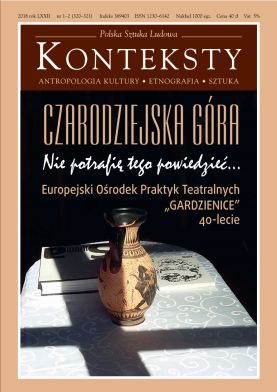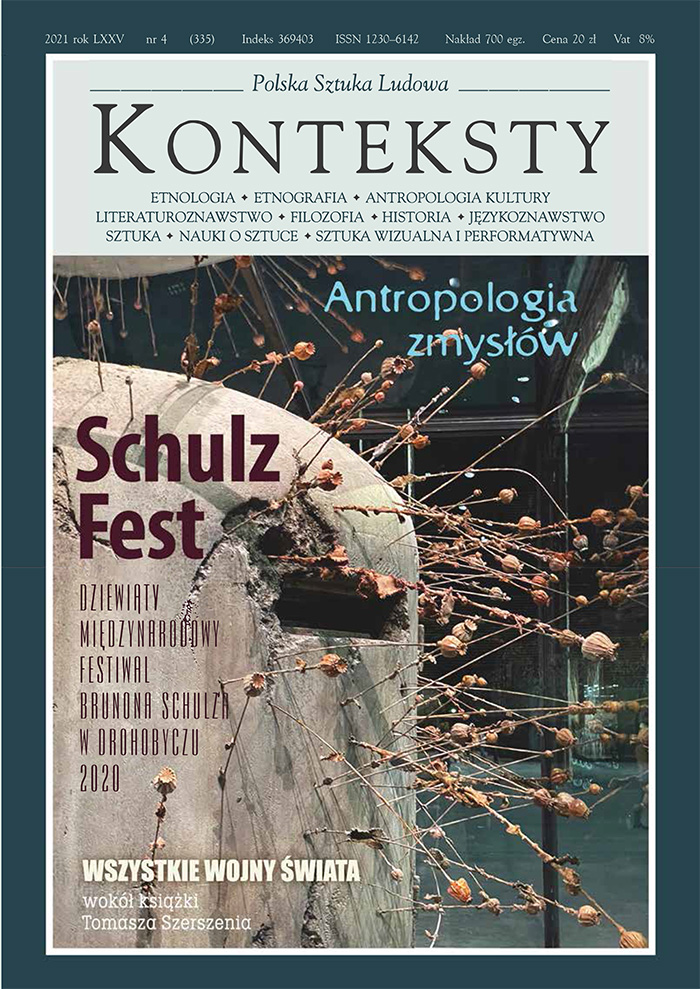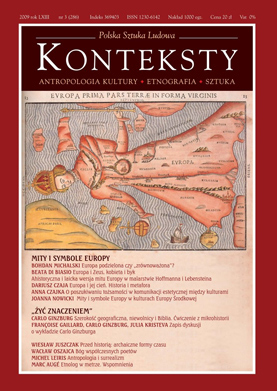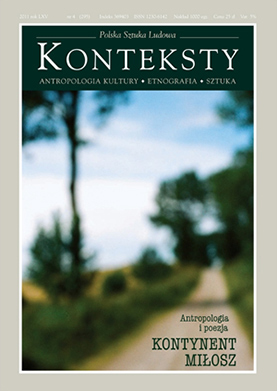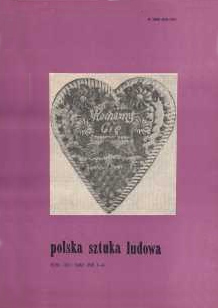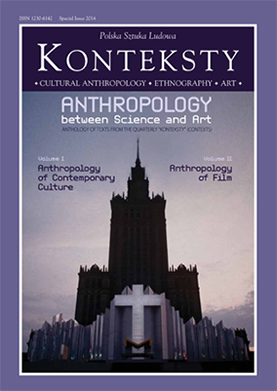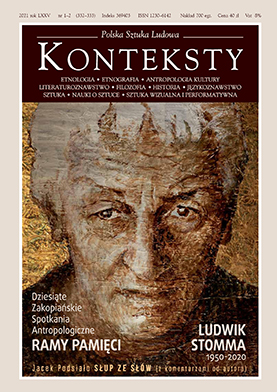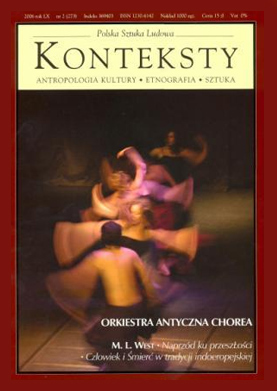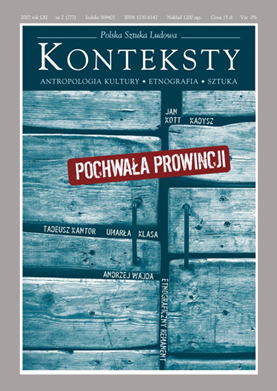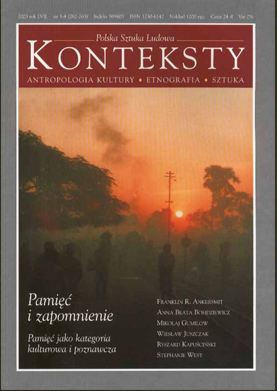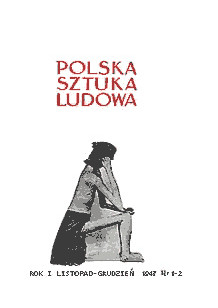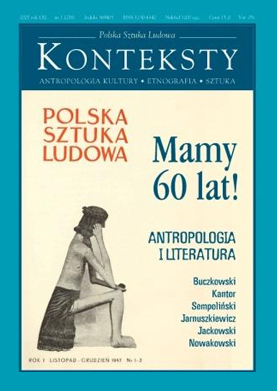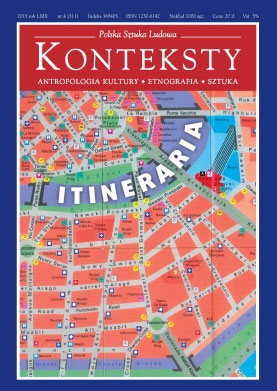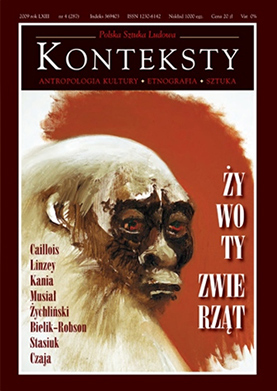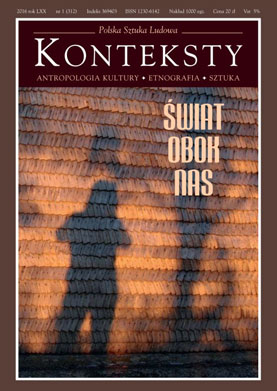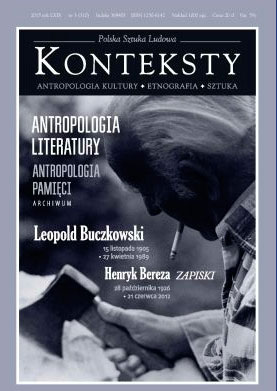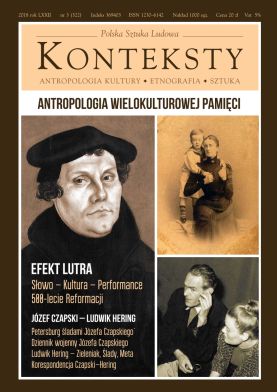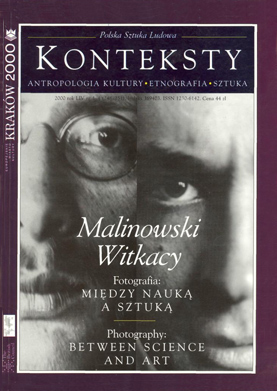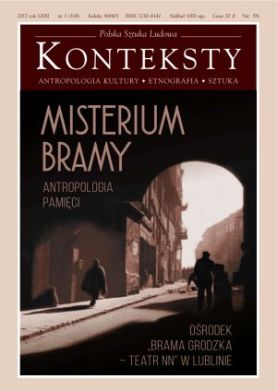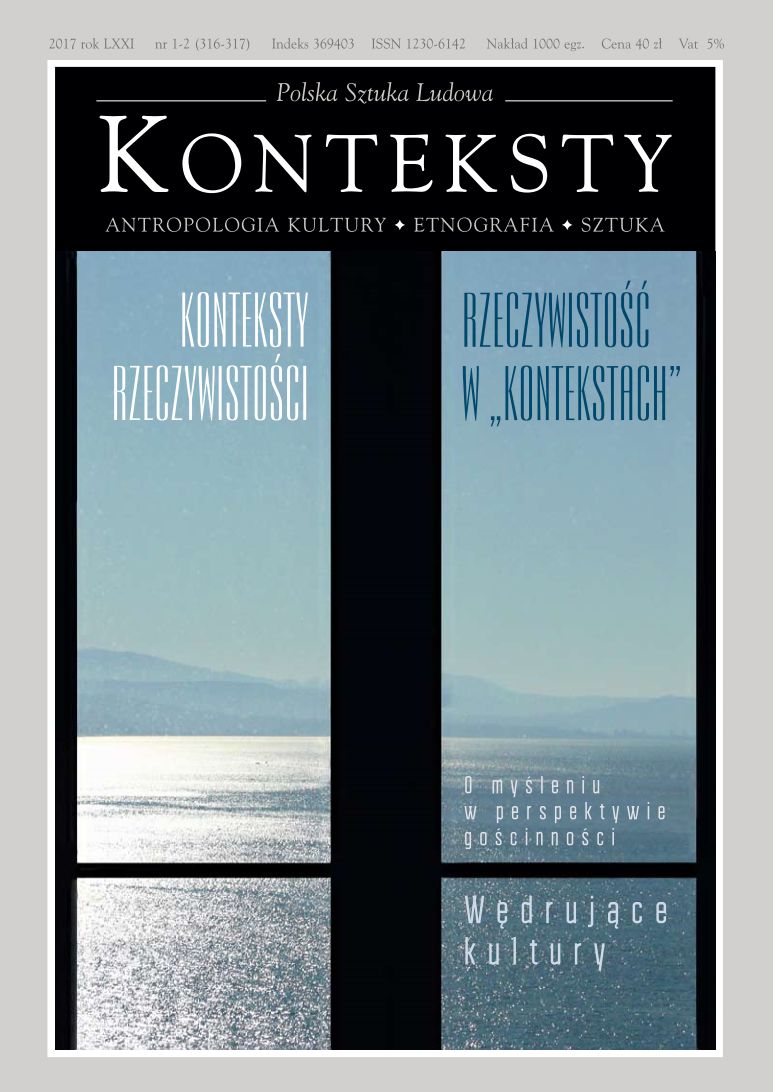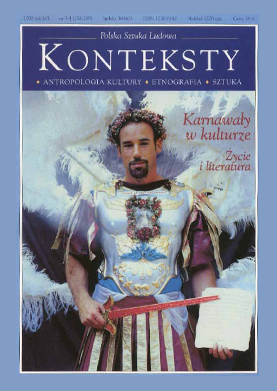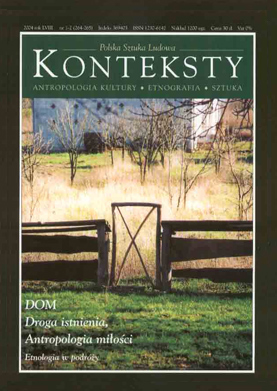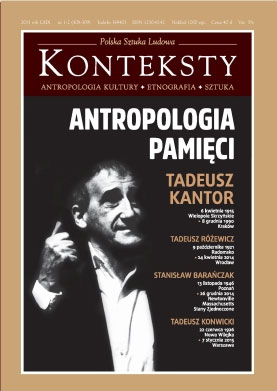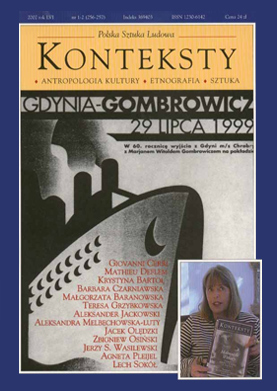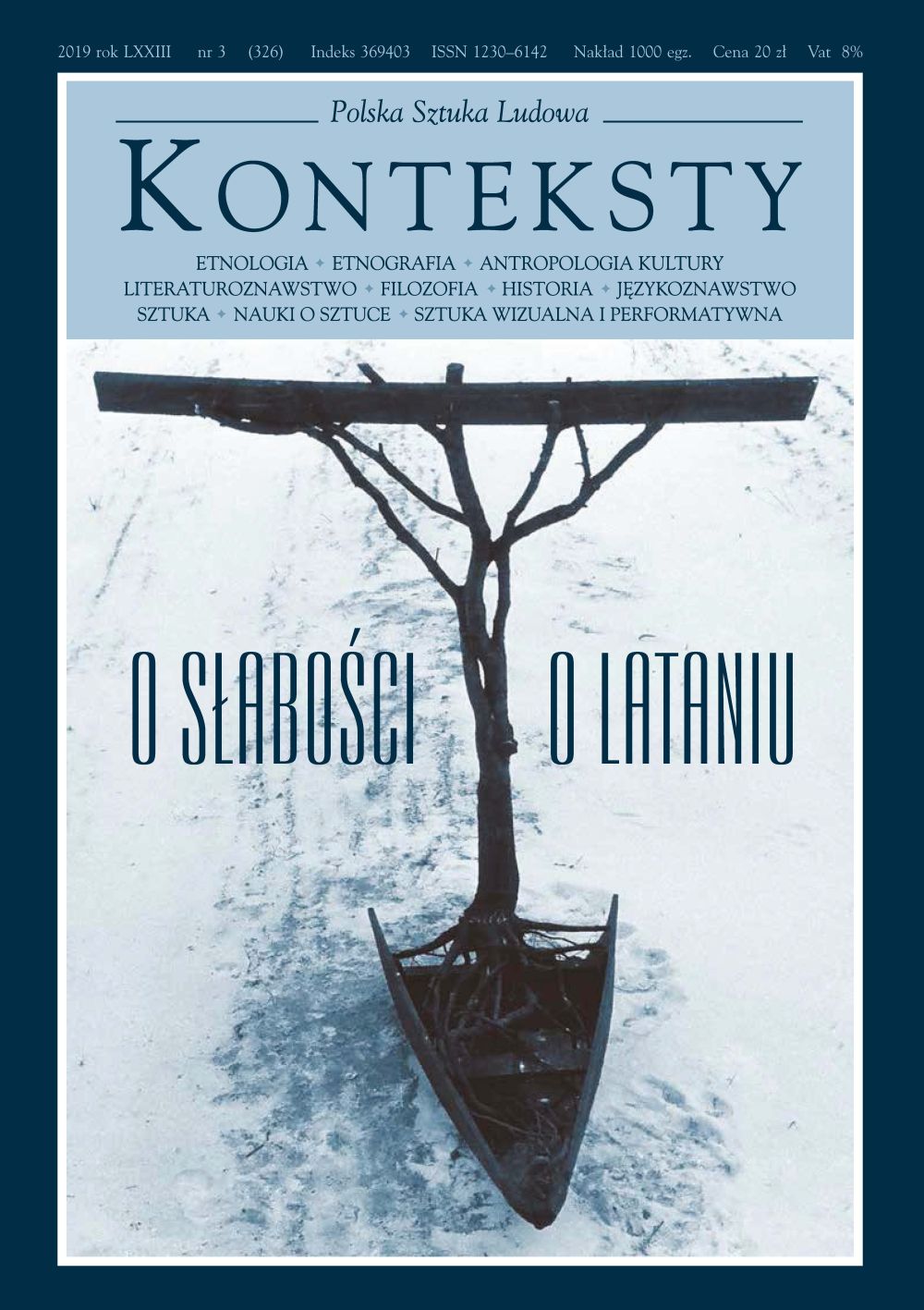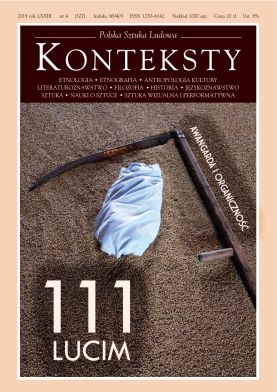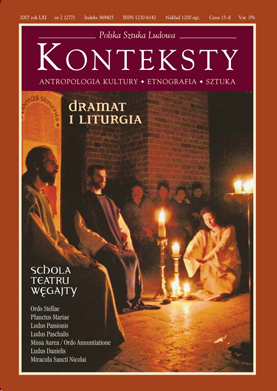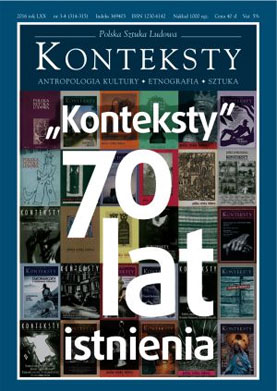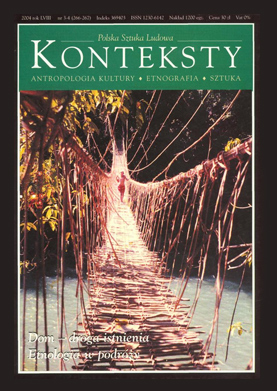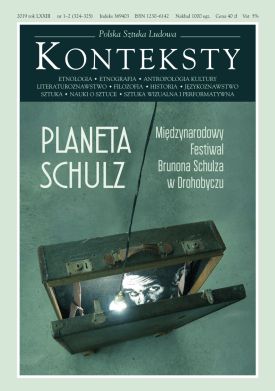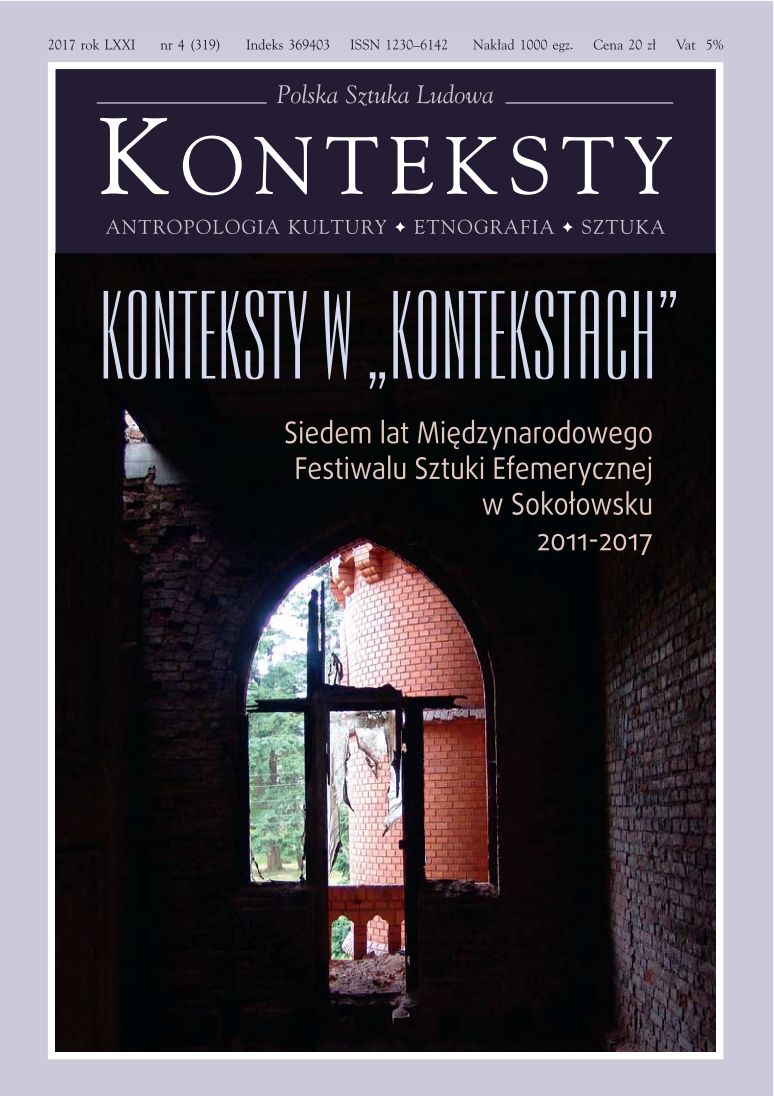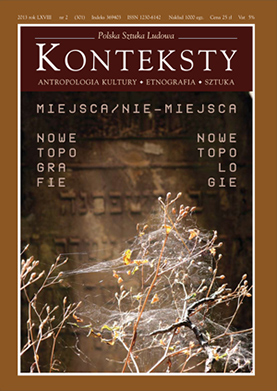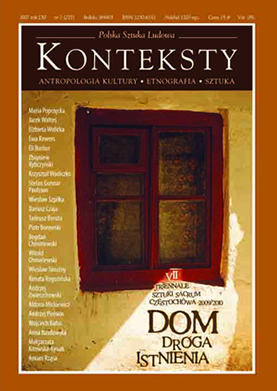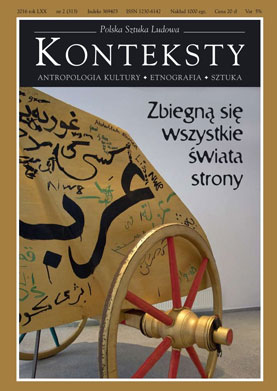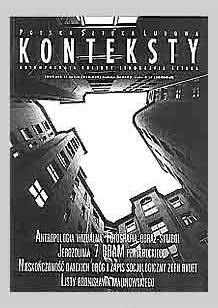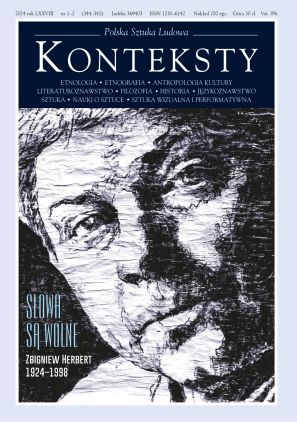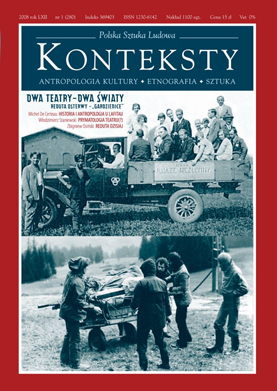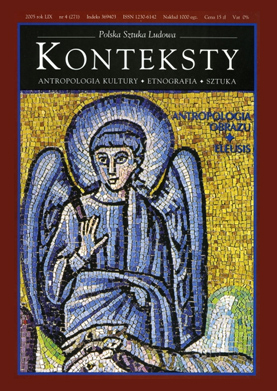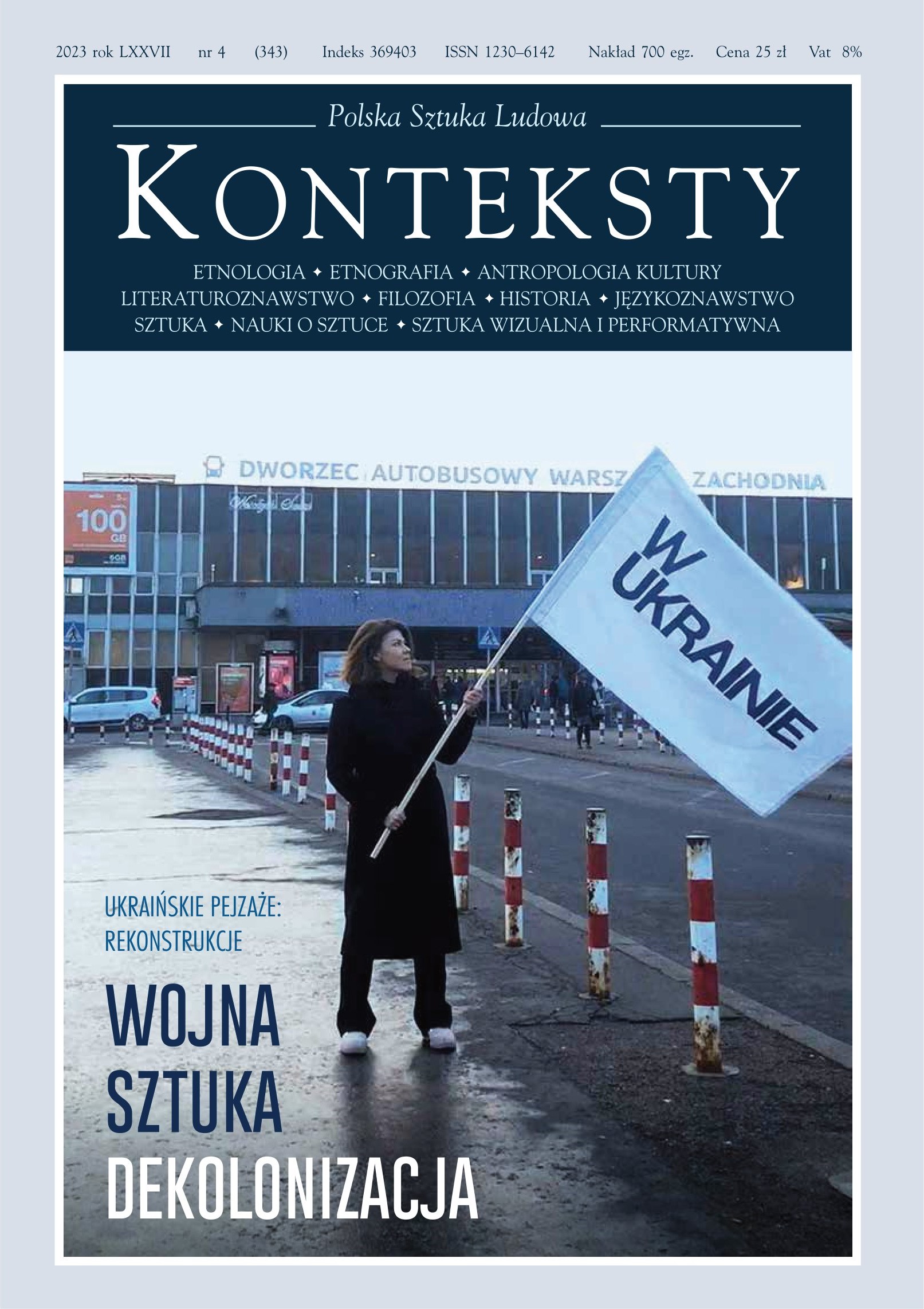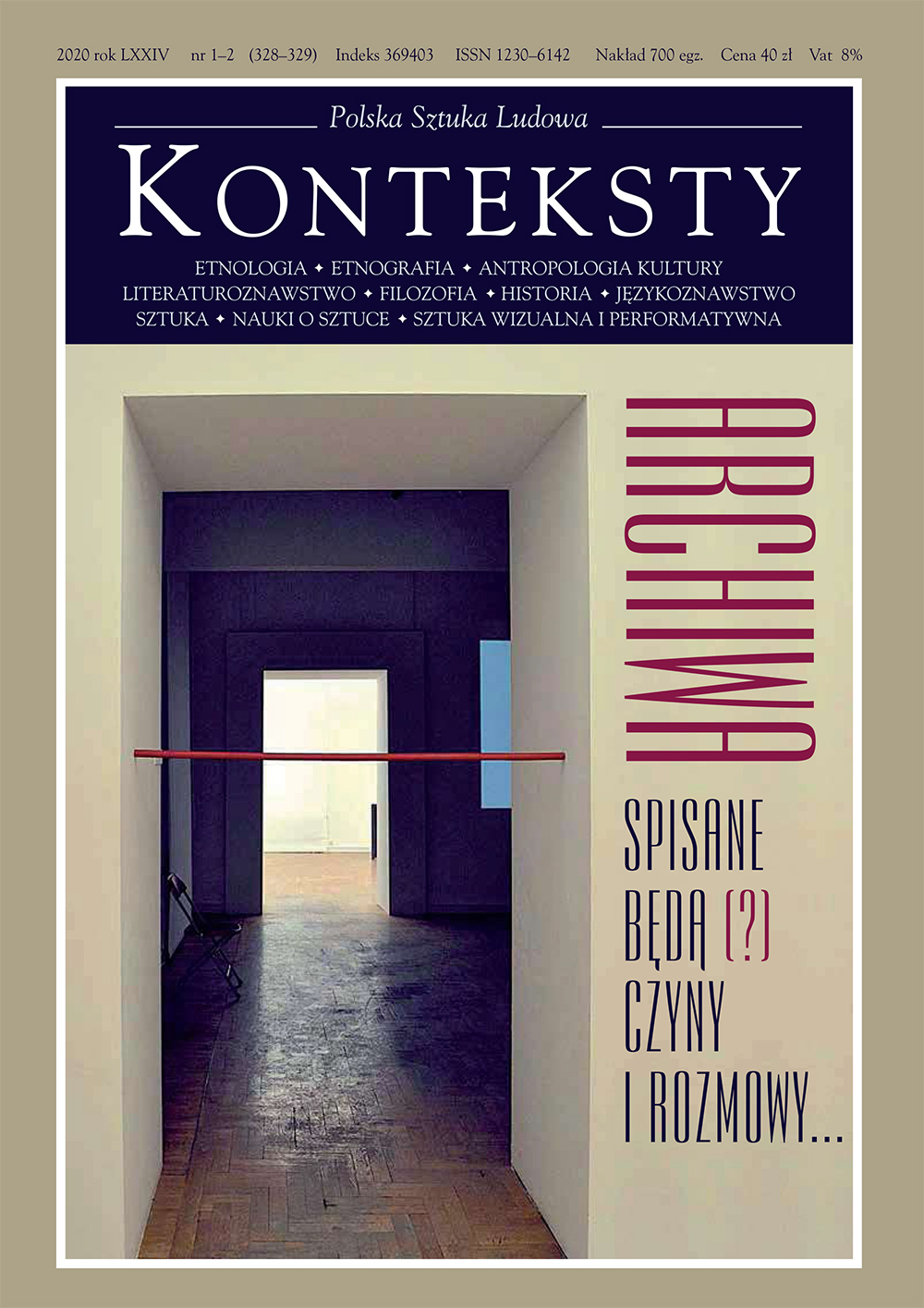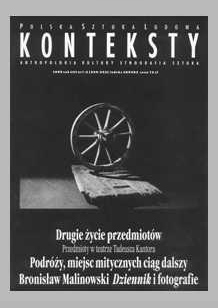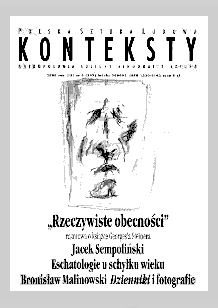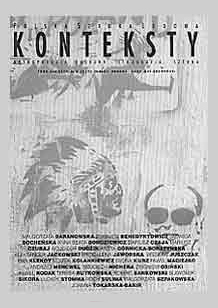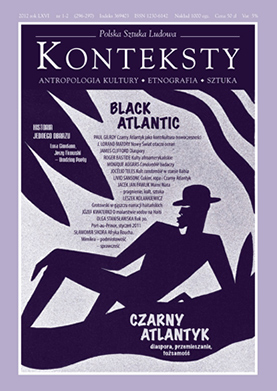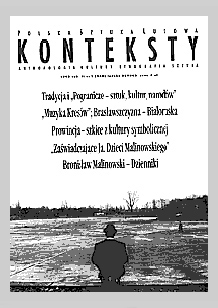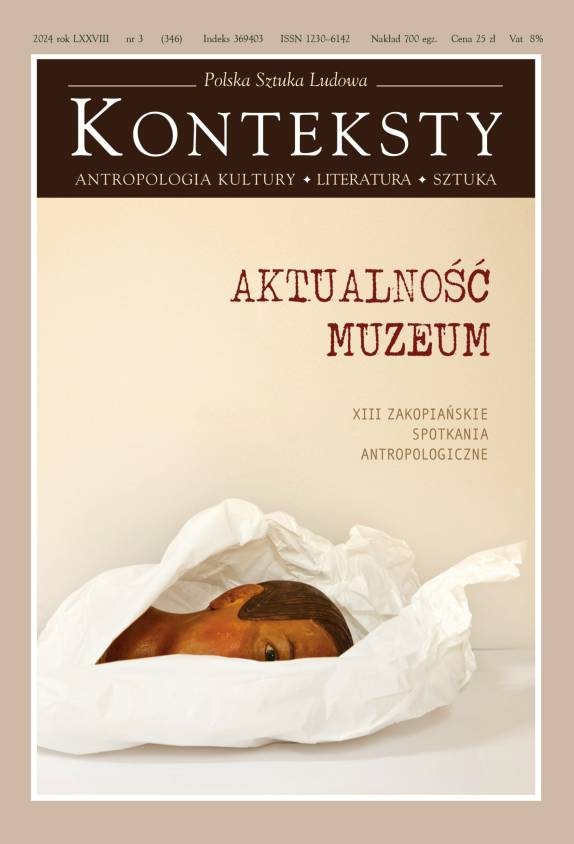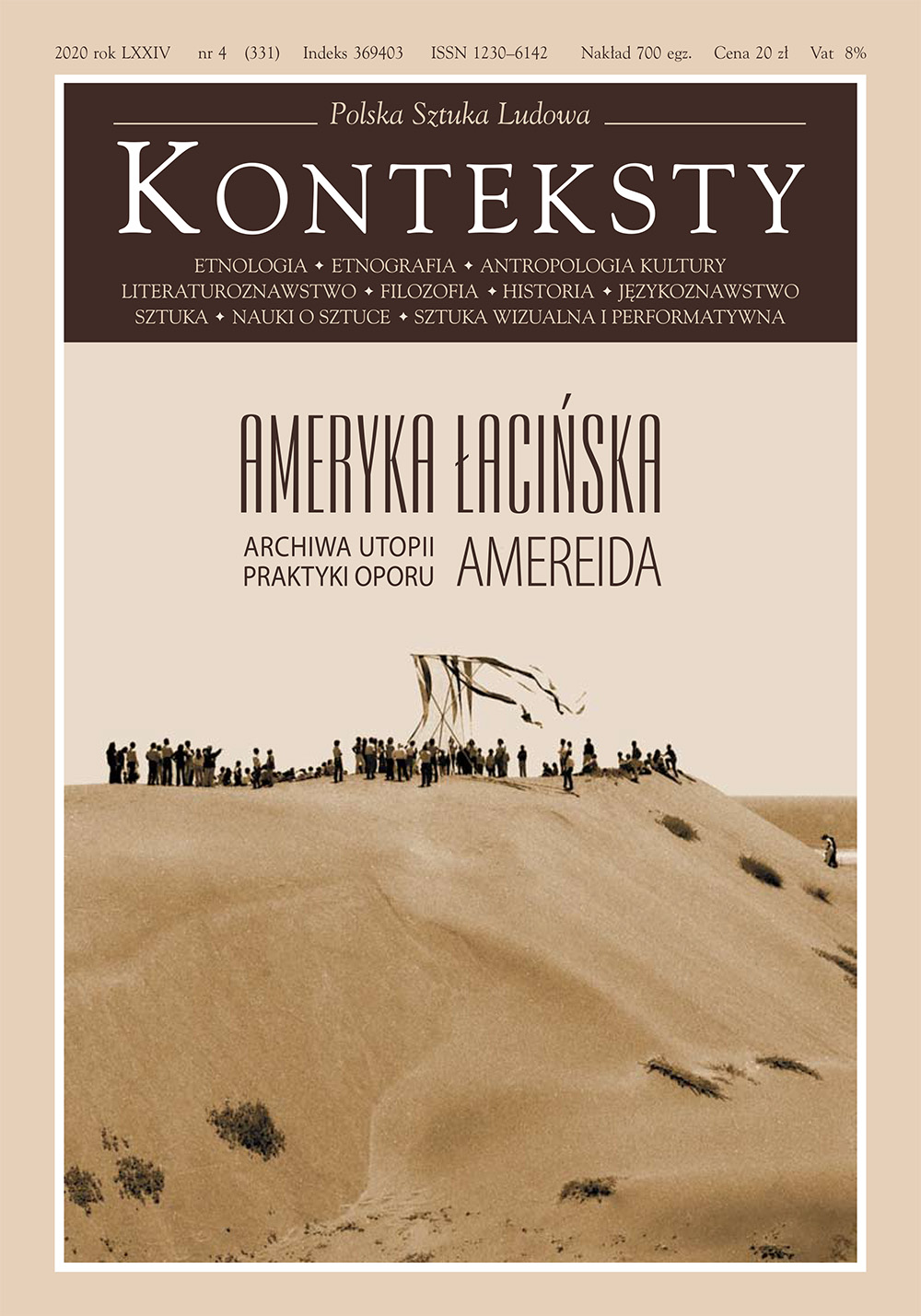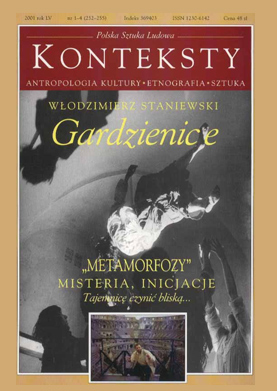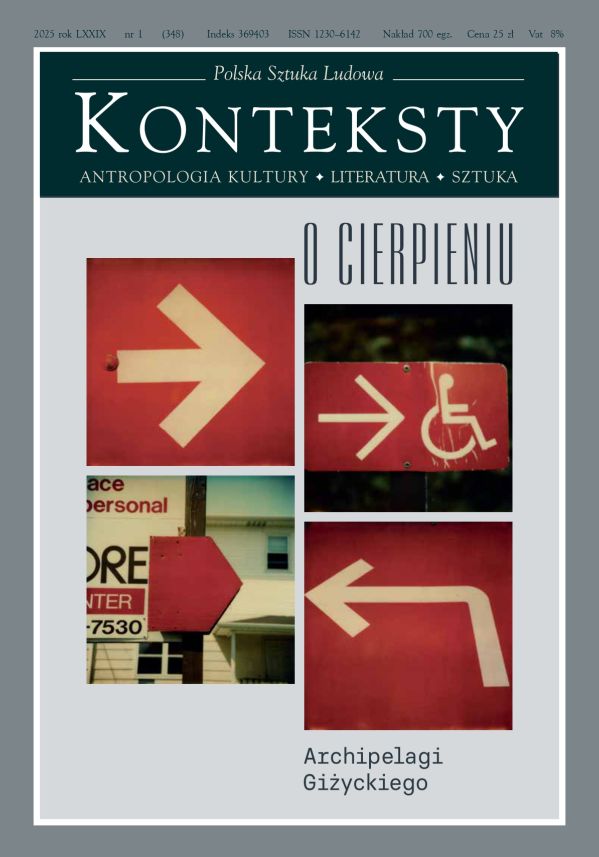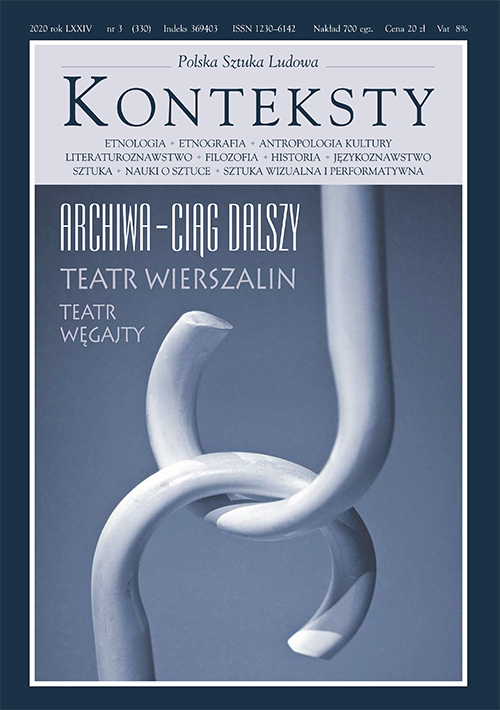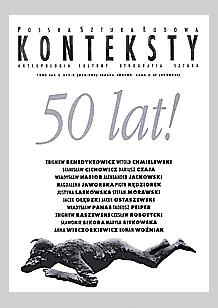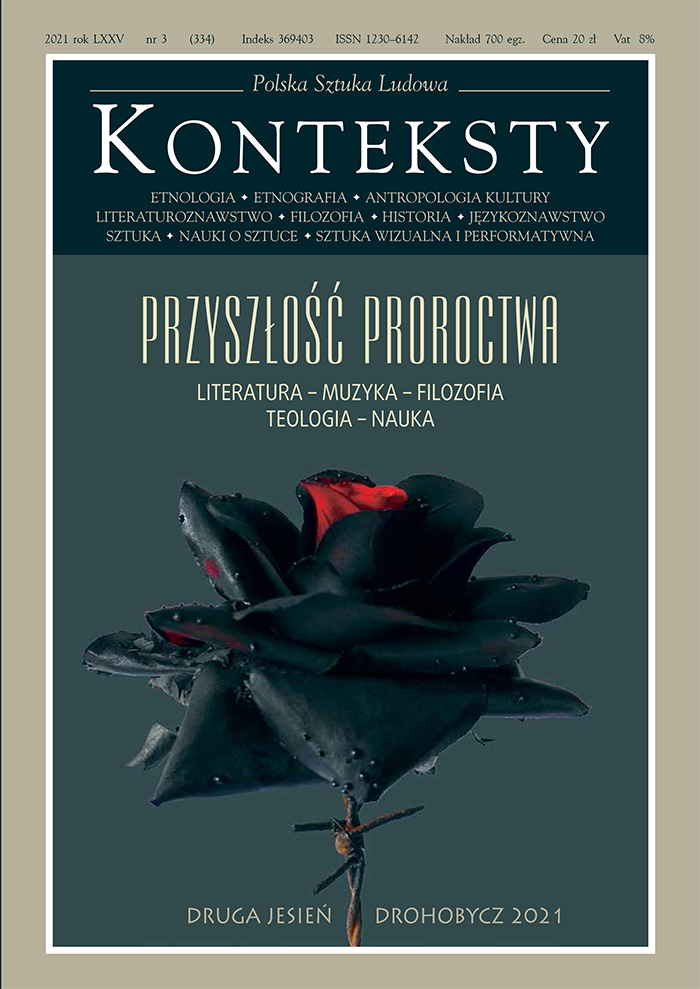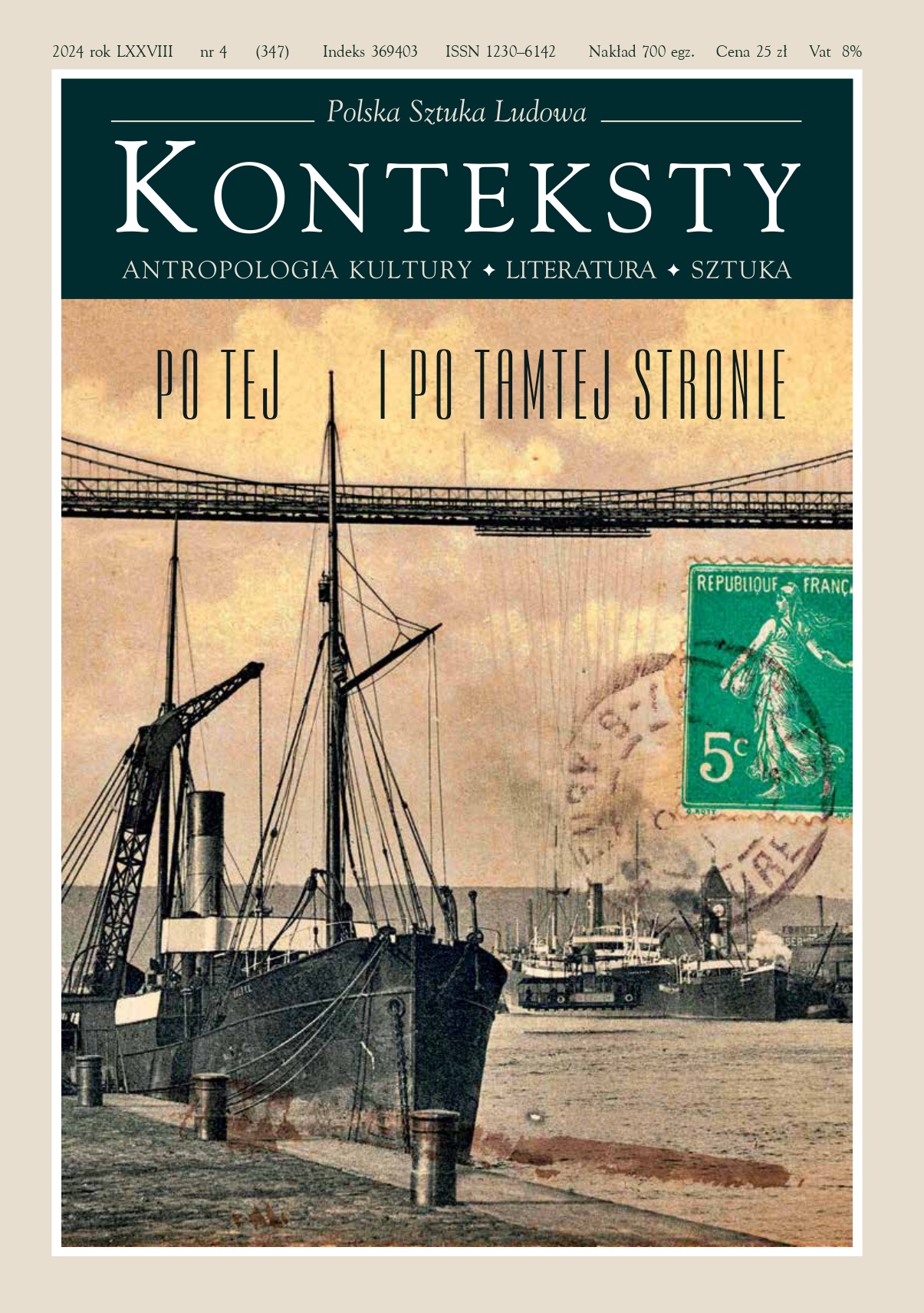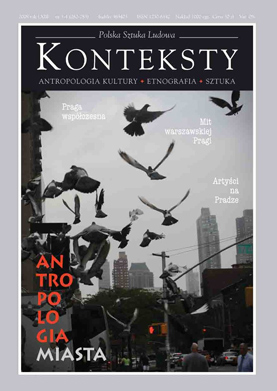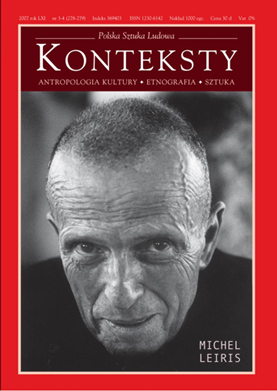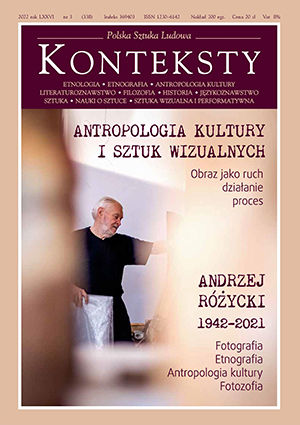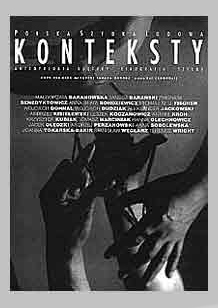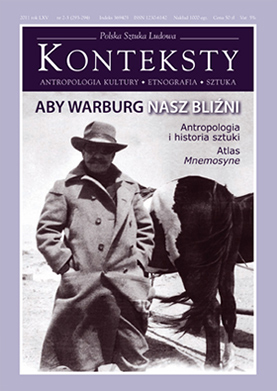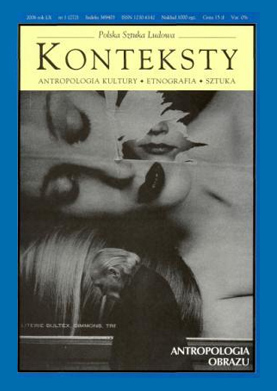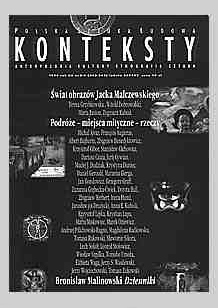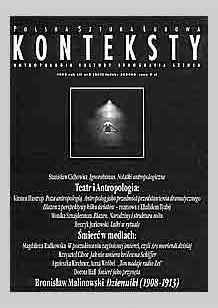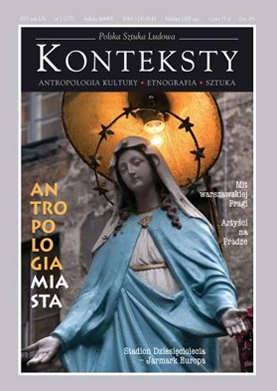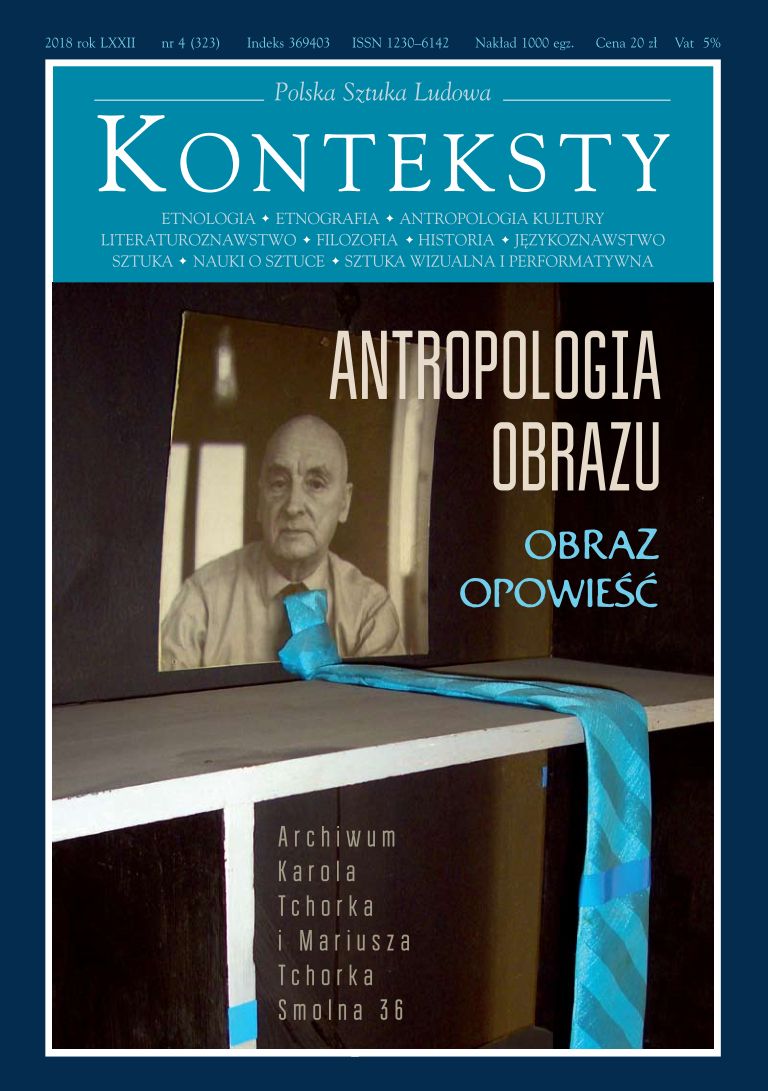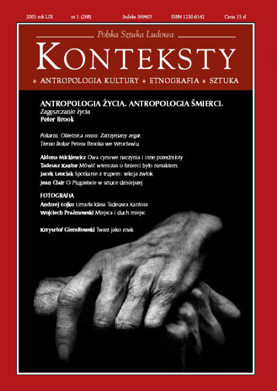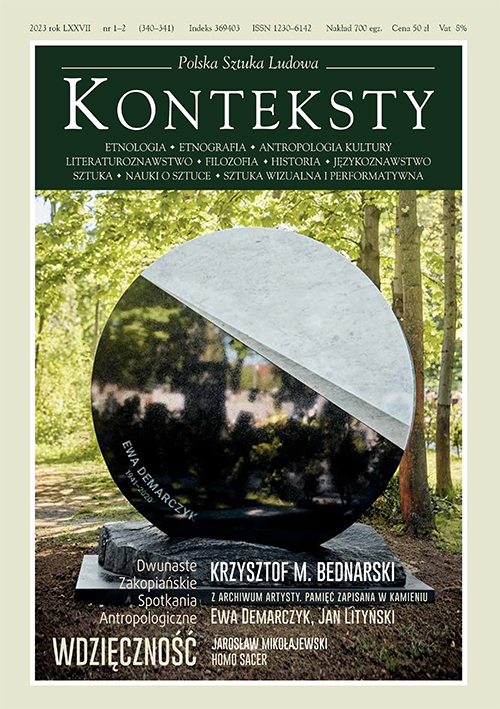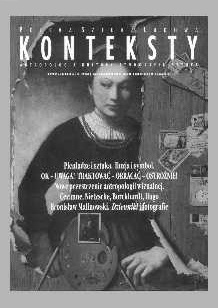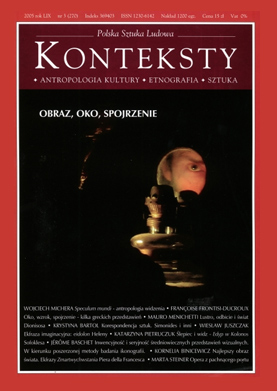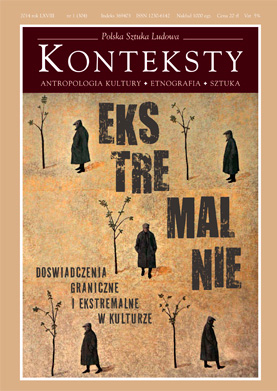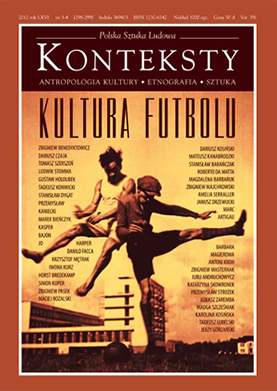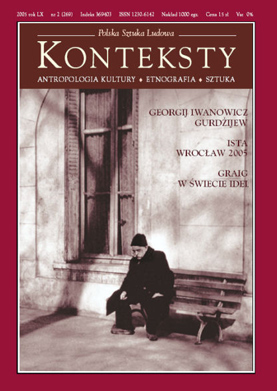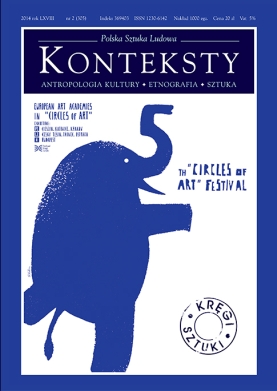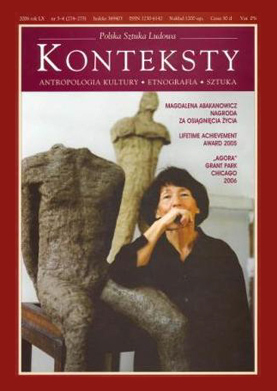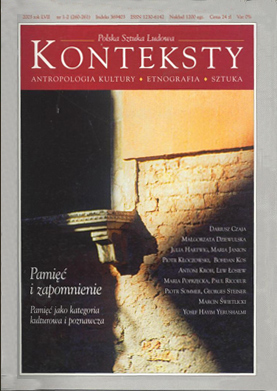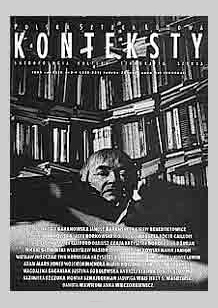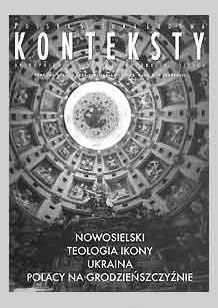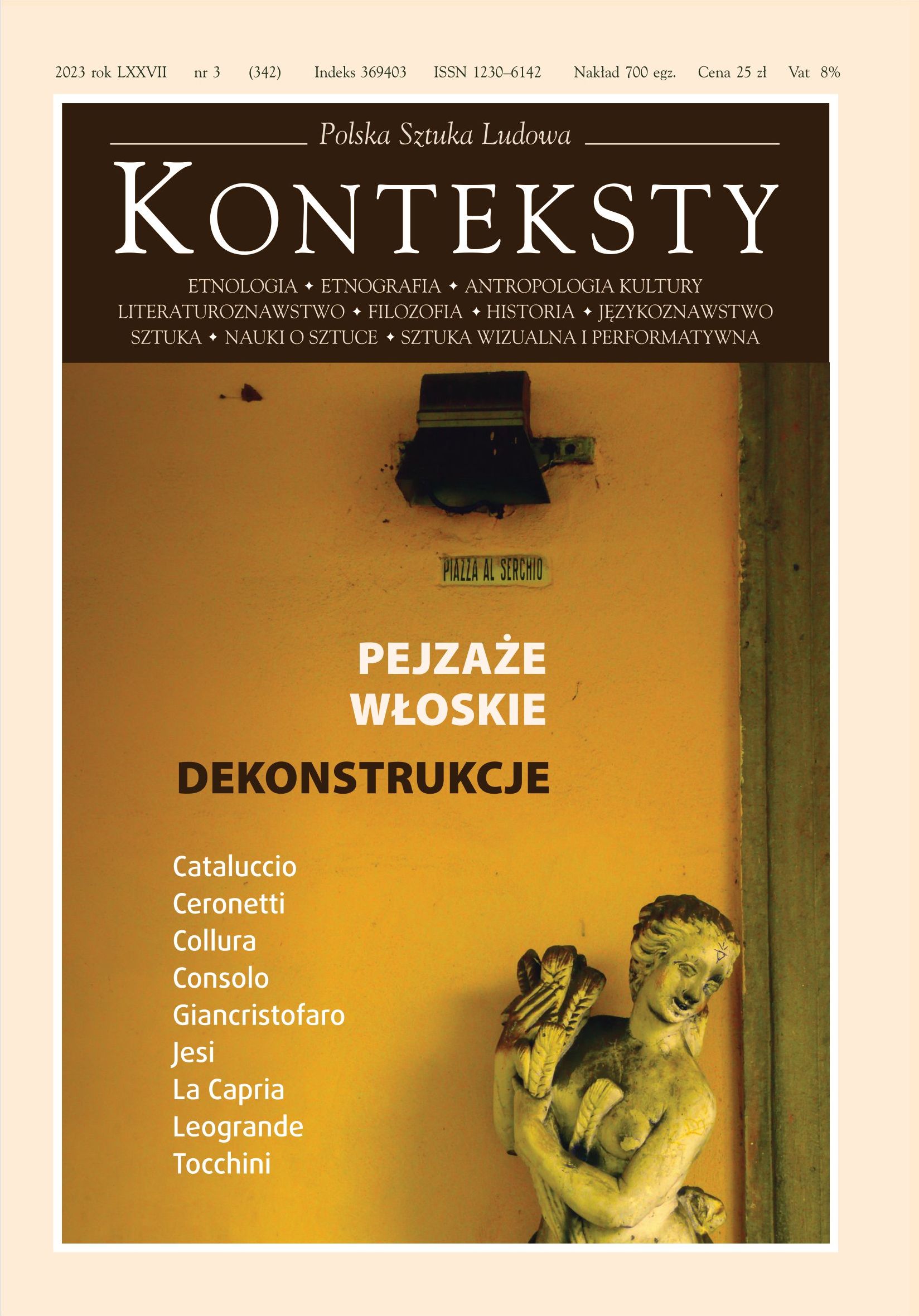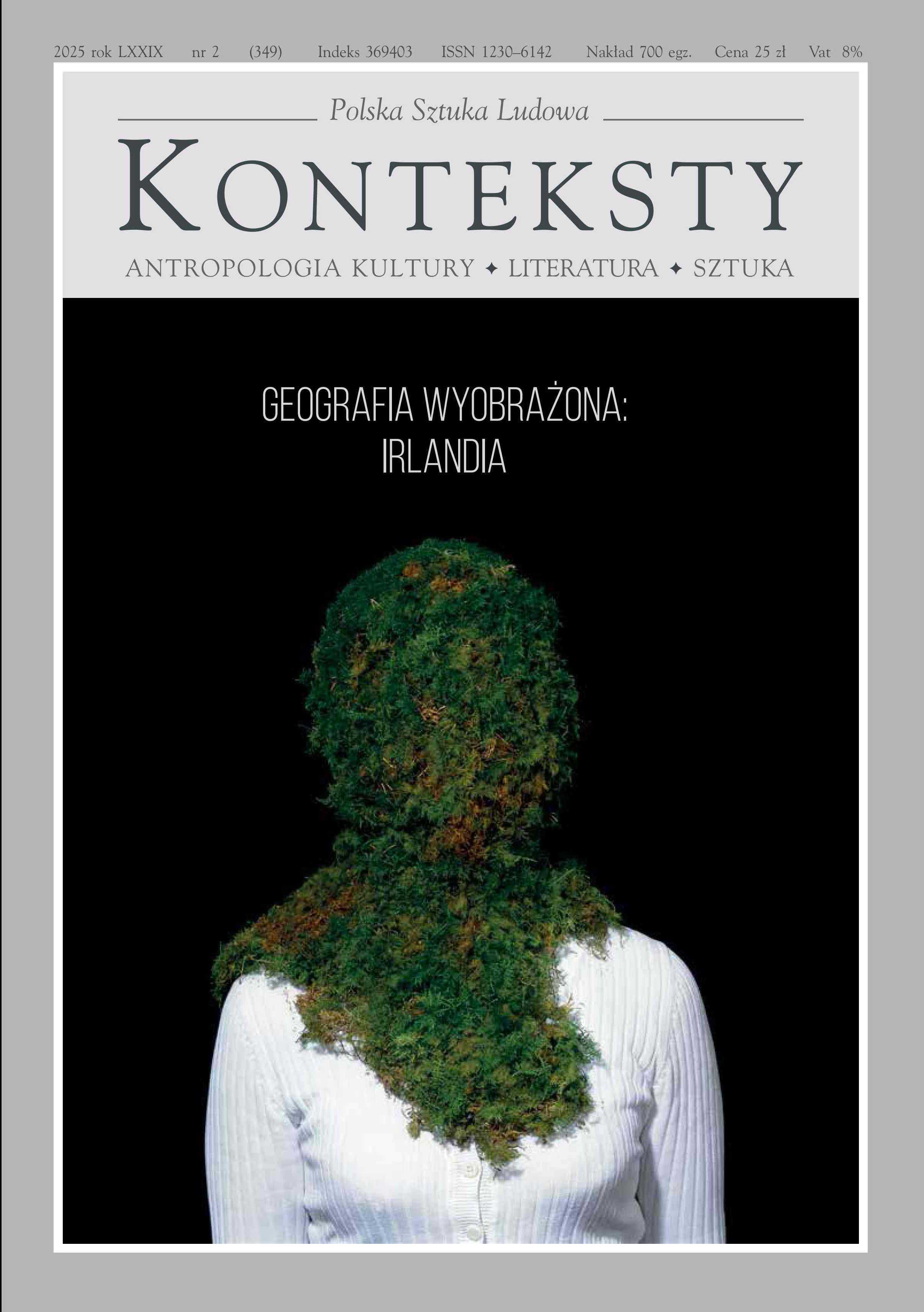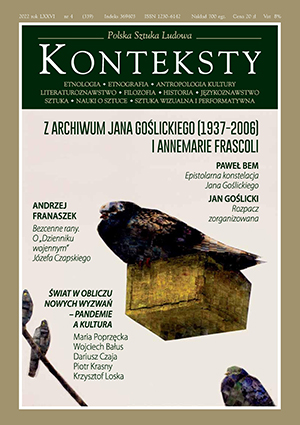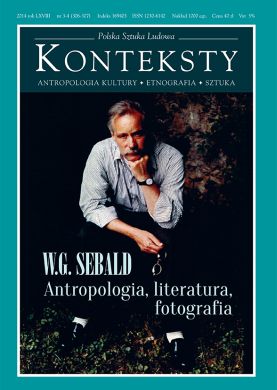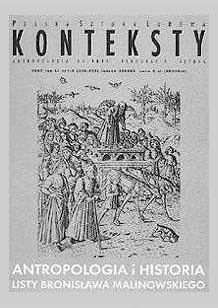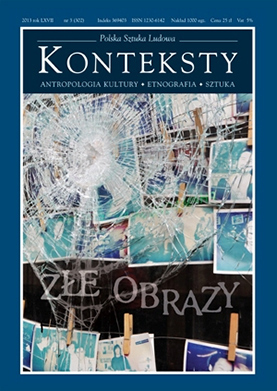Issue 2022/1-2 (336-337) - Zakopiańskie Spotkania Antropologiczne: Jutro / Międzynarodowy Festiwal Brunona Schulza / Teatr Węgajty
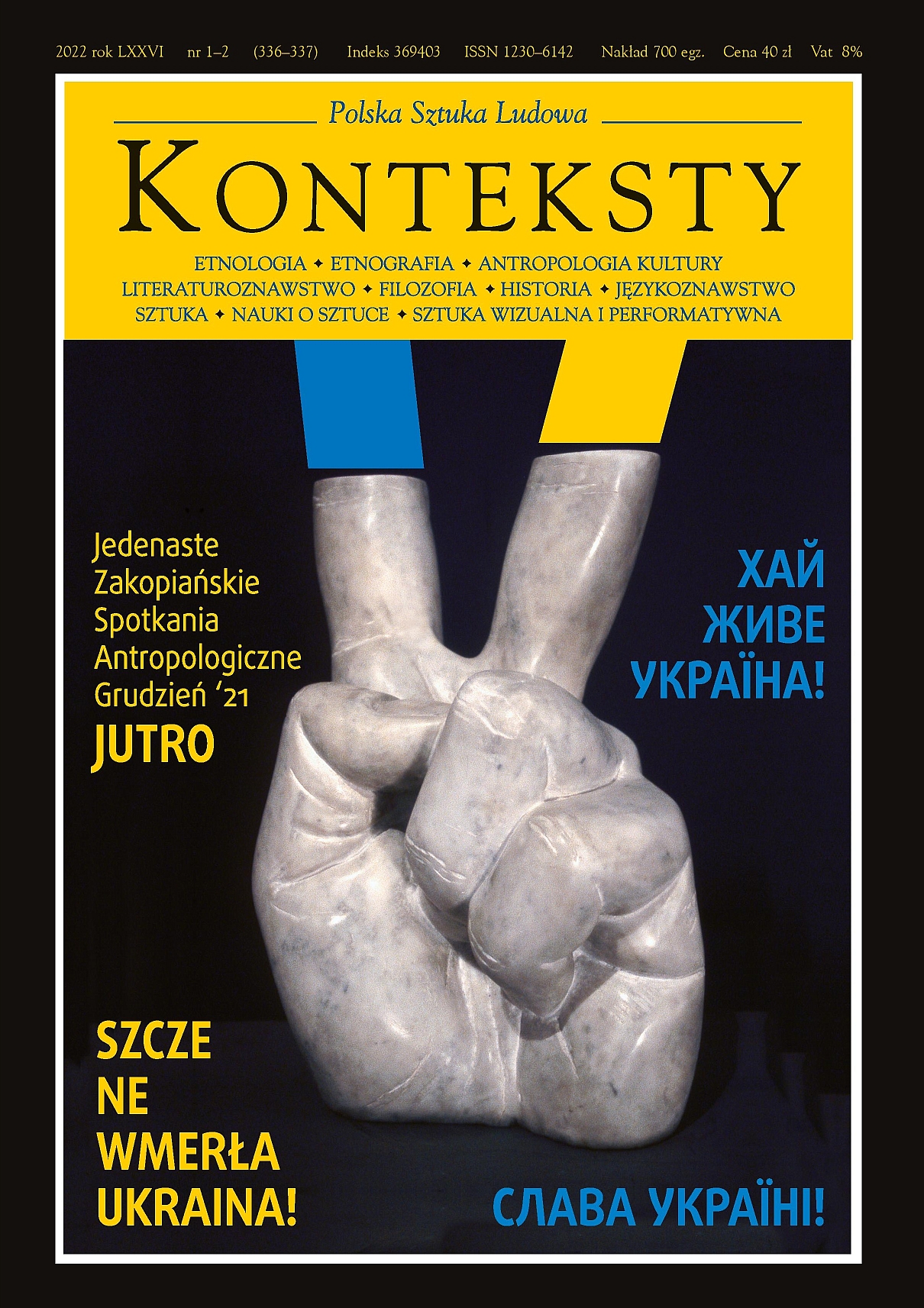
| *** | ||
| Zbigniew Benedyktowicz | Before Tomorrow  | 4 |
“Who am I ?” This is the question we ask ourselves at any age – as very young (and then just young) people, having reached maturity, and even at the end of our life. The question about identity: Who am I? How do I feel? How do I experience myself (and others)? Where did I come from? What is my origin? What is indubitable in me? Where are my limits? Those queries recur in films, repeats, reprises, repetitions, and images. “Self-Portrait as Felt” is a film inspired by a poem by Miron Białoszewski under the same title from his volume Obroty rzeczy (The Revolution of Things, 1957). The author analyses this short film story and Białoszewski’s poem within the context of the “Tomorrow” that awaits us. | ||
| Wojciech Michera | Cras leges  | 8 |
The author of the article – using the example of France at the turn of the nineteenth century – discusses the consequences of the great social reform from the mid-nineteenth century, i.e. the Rowland Hill postal reform in England and other countries. Due to the unification and lowering of tariffs (The Uniform Penny Post) traffic in the postal network reached the level of frenzy; by way of example, in Paris mail had to be delivered to addressees eight times a day. Nonetheless, researchers dealing with visual culture (e.g. Paul Virilio) focus on the category of “speed” and mistakenly treat the postal system of the era of Modernism as a relic of little interest and not as a key institution of the “modern” state. Meanwhile, the totality of the postal network during the second half of the nineteenth century redefined social relations, private and economic life, as well as the “discourse of power”. Taking those facts into consideration the author (referring to, i.a. Postcard by Jacques Derrida) considers the social consequences of the fact that the essential factor within the functioning of this network was the delay “co-efficient”: letters sent “today” reached the addressee “tomorrow”. Moreover, all postcards were social media of sorts and every postcard – an element of the constant oscillation of correspondence. In the social dimension, therefore, the postal network constituted an enormous, rhythmicised structure (here the author’s theoretical inspiration is the Henri Lefebvre rhythmanalysis conception). Finally, the article considers the dialectical relation between the figures of the flâneur and the facteur (postman). | ||
| Krystian Darmach | Distant Tomorrow or Tomorrow Never Knows by the Beatles and the John L. Schellenberg Conception of “Deep Time”  | 17 |
Conception of “Deep Time” The presented text concerns John L. Schellenberg’s “deep time” conception in reference to the proposed conference theme. I shall try to interpret the reflections of the Canadian philosopher in anthropological categories and within assorted contexts of thinking about the future, also in a confrontation with challenges of the contemporary world. The concept proposed by Schellenberg appears to be an interesting and untypical way of thinking about time, exercising human imagination vis-à-vis the limits and potential of his experiences. Additionally, I would like to decipher the author’s reflection within the context of the Beatles’ Tomorrow Never Knows. To search amongst presented proposals, unobvious parallels, and inspirations. To confront the musical composition, its form and contents with the order of discursive thinking about themes difficult to capture in scientific, formal categories. | ||
| Robert Louis Stevenson | The Song of the Morrow  | 22 |
The Song of the Morrow is considered to be the most intriguing of Stevenson’s tales. This tale about the mystery of life and time was issued two years after the author’s death (1896), and now appears in a first translation into Polish. | ||
| Stanisław Krajewski | Unknown Tomorrow: Between Hope and Threat  | 25 |
It is hard to predict the future, but we can analyse present-day trends and extrapolate. It seems that teaching, both in schools and universities, will be modified due to the accessibility of the enormity of Internet resources. This will be challenging, yet hopeful. Some count on achieving digital immortality. We may all expect pure and ethical in vitro meat. Changes will, however, threaten many people dependent on existing ways of functioning. (Cf. the collapse of printed encyclopaedias due to the Wikipedia). Certain novelties are dangerous to all of us: by using smartphones we are threatened with losing our privacy. | ||
| Paweł Próchniak | Natural Breathation Exercises in Poetic Respirology  | 31 |
Poetry is the breath of language. It animates language and grants it volatility. It is the reason why words resemble a gulp of air. At the same time, it allows them to breathe. In the light of such theses the author of this article analyses and interprets the “last poem” by Wisława Szymborska – a note written by the poet in hospital shortly before her death. Deciphering the note shows the way in which the “last will” of the author of Sto pociech transformed a poetic joke into an existentially enrooted act of the freedom of suitably used words, their living breath creating a powerful counterpoint for the last breath. It also demonstrates how Szymborska’s note opens a perspective for joint human experiences associated with the “battle for breath” and for profoundness opening up in each breath – also in the last one. | ||
| Tomasz Wiśniewski | New Opening of the Abbey Theatre in Dublin  | 35 |
The article discusses iGirl, a performance by Marina Carr, directed by Caitríona McLaughlin – Ireland's new artistic director of the Irish national theatre – with Olwen Fouéré in the title role. The performance not only marks the first premiere for the new management, but is also the opening of theatre after a long period of lockdown. For this reason, the performance defines the program of this institution for the forthcoming months and years. The vision of future artistic development as depicted by Carr / Fouéré / McLaughlin is contextualised with the work of Beckett, Complicité, and the Irish Literary Revival. In connection with the opening of a new opening in Dublin art theater, acting to create co-creation with pandemic-19. | ||
| David Malcolm | No More Tomorrows? Mollie Panter-Downes, the Future, and Canonicity  | 41 |
At the end of Mollie Panter-Downes’s novel One Fine Day (1947), Laura the protagonist runs down a hill in the evening to meet the next day. The reader never learns of her tomorrow. In this paper, I consider how the notion of an unrealized tomorrow recurs throughout Panter-Downes’s fiction and non-fiction. I also consider how her status today as a non-canonical writer – one without tomorrows – is shared by a group of women writers from the mid-twentieth century: Sybille Bedford, Mary Renault, Bryher, Betty Miller, and Sylvia Townsend Warner. | ||
| Magdalena Barbaruk | A Life to Be Constructed. On the Possibility of a Return of Edward Stachura  | 45 |
The point of departure of this article is an interpretation of an exhibition of K.M. Bednarski’s Symbols of Life after Death. The author analyses the status of the artist’s famous headstones within the context of relations between the dead and the living, which became the topic of research conducted by V. Despret, an anthropologist of science. M. Barbaruk agrees that thanks to the concept of construction (B. Latour) it is possible to speak about the deceased with whom we maintain assorted complicated relations, just like about works of art. This calls for a suitable “milieu”, or, according to Barbaruk, an interpretation which she describes as Orphic. Barbaruk shows that such is the attitude towards the deceased Edward Stachura assumed by Danuta Pawłowska-Skibińska, who many years after his death decided to return to his old letters and to reply to them. Consequently, Stachura received a chance for a new existence, different from the legendary one. Barbaruk embarked upon a similar interpretation gesture vis-à-vis Stachura by discovering his until now unknown relations with a group of Latin American artists and poets (i.a. G. Iommi, M. Deguy, E. Simons) active in Paris, where from the 1960s they organised phalènes. Barbaruk came across a surprising presence of “stachura” in Amereida, a poem written during a decolonisation expedition to South America (1965). She also drew attention to the role played by Juan Pablo Iommi Amunátegui at the time of Stachura’s stays in Paris (1977, 1978) and to the need to find letters exchanged by Stachura and Edison Simons, a poet from Panama. | ||
| Paweł Drabarczyk | Dreamt Revolution. On November by Jakub Woynarowski  | 54 |
In 1794 November (Polish: listopad) could have still turned into Novembre, the first month in the non-existent Polish revolutionary calendar. At least, this could be the assumption made while browsing through the visual essay by Jakub Woynarowski, a historical variation on the theme of the Kościuszko Insurrection. The process of comprehending alternative history signifies also taking a look at oneself in one’s dream, in which the longing for modernity, in reality never accomplished to the very end – that tomorrow which never comes, has an obverse in the form of “fear of modernity”. November is suffused with viscous elements of melancholy, such as mud, that emblematic suspension of November and possibly even the quintessence of Polishness. Not only armies veer – the same is true of ideas, always becoming misshapen far from the metropolises that gave birth to them. Ideas are not only deformed by mud but in some way tamed and moulded into something that is known and familiar. Mud is, simultaneously, a curse and – ex luto lux! – a blessing. When “tomorrow” flounders in it, it becomes possible to dream safely about it. | ||
| Piotr Jakub Fereński | Tides  | 62 |
A text dedicated to questions connected with the city, new technologies, the pandemic, and working from home. While outlining the history of the idea of the digital revolution in the USA and China – mainly referring to the prognoses of the American futurologist and writer Alvin Toffler – the author asks about the further development of digital revolution, the civilizational future of the West and its liberal democracy, changes within the functioning of individuals and communities, the transformation of the system of the production and distribution of goods, the new organisation of workplaces, and the contemporary role of towns. He is guided by a sentence written by Rudolf Arnheim, the eminent German theoretician of visual culture: “But doing things at the same time and doing them together is not quite the same”. | ||
| Jacek Leociak | The Abyssal Time of the Ghetto and the Perspective of “Tomorrow” Leib Goldin, Stella Fidelseid, Janusz Korczak  | 73 |
Existence in the ghetto was tantamount to descent into an abyss, also an abyss of time. Barbara Engelking („Czas przestał dla mnie istnieć”. Analiza doświadczenia czasu w sytuacji ostatecznej, 1996) formulates the conceptions of “abyssal category”, “abyssal situation”, and “abyssal time”. The term, which originates from the Greek abyssos, describes the ghetto experience / the experience of the Holocaust. Time spent in the ghetto is abyssal, a life in the fissures of time. I consider testimonies written there and then: the essay about hunger by Leib Goldin, the account by Stella Fidelseid (hiding in a bunker from the outbreak of the Warsaw Ghetto Uprising all the way to December 1943), and fragments of Pamiętnik by Janusz Korczak, and seek in those records something that might be described as “the perspective of tomorrow”. Furthermore, I ponder on how the horizon of “tomorrow”, comprehended literally as the next day and metaphorically as a distant or near future, can reveal itself in abyssal time, bereft of the past and the future and submerged in the extreme “now”. | ||
| Monika Sznajderman | Drohobycz – Gorlice Fragment of a Larger Whole  | 81 |
This is a story about a journey – real and mental – against the background of a war or actually two wars. A voyage under the banner of Bruno Schulz and Serhiy Zhadan, from Drohobycz to Gorlice, a small town in the Carpathian Mts., in which more than half of the pre-war population was composed of Jews, almost all of whom died in the Holocaust. The town grew on their blood and bodies. But this is also a journey beyond the town’s material dimension, to the land of shadows which had never departed but are still there. The past has not disappeared – on the contrary, it has as if accumulated and settled down on walls and trees, in the air and on the paving. The author follows traces and is interested in that, which at present is poorly known, unfamiliar, marginal, ignored, forgotten or slighted. In doing so, she attempts to extract from non-existence the stories of those about whom very little is known, and to establish a language in which we could talk to them. A language that, to cite Professor Roch Sulima, constitutes seeing through “nothingness, a process of coming nearer to the world with tenderness and not with perception-rule”. | ||
| Katarzyna Prot-Klinger | Last Witnesses Are Dying. On the Memory of the Holocaust  | 95 |
The author describes ending her 25 years long therapeutic work with the Holocaust Survivors. In doing so she wonders what sort of processes made it possible to work through mourning connected with the conclusion of the programme and the death of the Survivors. In addition, she proposes a hypothesis maintaining that social processes associated with the pandemic and the climate catastrophe brought the reality of death and the procedure of coming to terms with it closer. The text ends with a reflection concerning the memory of the Holocaust after the death of its last witnesses. | ||
| Michał Klinger | Moment and Eternity the Timelessness of the Text  | 101 |
The author embarks upon the problem of experiencing the “moment” as a dilemma of choosing its fullness while facing claims made by time and eternity. The proposed hypothesis maintains that only the moment creates texts, the myth is timeless, and the aspect of temporality is a quasi-text, a “film” illusion. Above hovers the demand of transcendence. | ||
| Dariusz Czaja | “I am coming soon”. Apocalypse Now  | 111 |
The Apocalypse of St. John is one of the exegetically most difficult books of the New Testament. Only in this case do there exist numerous uncertainties concerning absolutely fundamental questions: authorship, time of origin, and meanings projected by this extraordinary text. The vision of “the end of all things” presented in the prophecy from Patmos is also highly enigmatic. The exact meaning of key expressions referring to the future: “The time is at hand” (1, 3; 22, 10), “I am coming soon” (3, 11; 22, 12), “Yes, I am coming soon” (22, 20) is not quite clear. The author proposes to decipher the vision of the future presented in St. John’s revelation not chrono-logically but kairo-logically. In a thus understood “time of the Apocalypse” the word: “soon” should not be understood as a distinguished moment at the end of time. The expression from Ap. 1, 3: “The time is at hand” shall, therefore, not signify some sort of an unusual event from the indefinite future or a distinctive moment of time but refer to each moment in turn. The thus understood apocalyptic quality is simply another name for the temporality of human existence. A thus comprehended apocalypse occurs incessantly. | ||
| Łukasz Stypuła | “Next Year in Jerusalem!” Several Remarks on Leviathan  | 118 |
The Sukkot holiday ends with the words: “May it be your will, Lord our God and God of our forefathers, that just as I have fulfilled and dwelt in this sukkah so may I merit in the coming year to dwell in the sukkah of the skin of Leviathan. Next year in Jerusalem”. This is a reference to a fragment of the Talmudic treatise Bava Batra 75a: “Rabba says that Rabbi Yoḥanan says: In the future, the Holy One, Blessed be He, will prepare a sukka for the righteous from the skin of the leviathan, as it is stated: ‘Can you fill his skin with barbed irons [besukkot]’” (Job 40:31) (“Can you draw out Leviathan with a fish hook? … Or pierce his jaw with a barb?” [Job 40, 26]). In the light of the cited words and wishes expressed upon numerous occasions during assorted Jewish holidays I shall refer “Next year in Jerusalem” to Leviathan – the Book of Job – Light – the Messiah within the context of Lublin – the Exodus – Darkness – the Apocalypse. While using the image of the eschatological feast I would like to deliberate on “the temporal quality” of tomorrow and ask whether the Messianic mark distinctly reflected in the words of this blessing abolishes existing order and is a new / successive beginning. | ||
| Wiera Meniok | Spring Which Still Yet Has Not Been… and Tomorrow – Second Autumn  | 126 |
The co-creator of SchulzFest writes about tomorrow – ensconced in yesterday and for this reason emerging from the latter. The text contains intermingled motifs connected with the texts: Wiosna (Spring) and Druga jesień (Second Autumn) by Bruno Schulz as well as the Second Autumn literary-artistic project organised for the past twenty years in Drohobych upon the anniversary of the writer’s death. Wiera Meniok also mentions the tomorrow of another, meta-Schulzian Second Autumn and “Acta Schulziana” dedicated to Schulz, whose particular volumes she discusses in detail. | ||
| Łukasz Sochacki | Tomorrow’s Ends of the World. Scientific Apocalypse  | 133 |
The essay discusses the topicality of Apocalyptic imagination in contemporary European culture. The author’s sources consist of popular science articles published in the Polish opinion-forming press (dailies and weeklies). Łukasz Sochacki attempts to justify the belief that the “end of the world” category is an ever-present matrix for comprehending reality, while the question about the end of the world has a mythological and anthropological meaning. | ||
| Maciej Krupa | Walking in the Netherworld. Purgatory  | 147 |
In his essay about Dante Osip Mandelstam drew attention to the considerable awareness of walking in The Divine Comedy. A meticulous reading of the most recent and literal translation of that work into Polish by Jarosław Mikołajewski proves that in his description of conquering Montagna del Purgatorio Dante wrote openly about mountain ascent. The original prototype of the mount of Purgatorio is probably Pietra di Bismantova in the Apennines. Dante’s work appears to be the first description of mountain climbing in the history of world literature and precedes Petrarch’s famous text about ascending Mount Ventoux by twenty years. | ||
| Tadeusz Bartoś | Has Yesterday Already Been?  | 151 |
A question about tomorrow also asks about the existence / non-existence of the future, the past, and the present. The most momentous opinion is that of Augustine of Hippo. An analysis of various possibilities of speaking about the non-existence / existence of tomorrow poses a question about the likelihood of understanding existence / non-existence. Creationist metaphysics, within whose range Augustine functioned intellectually, is a radical severance with the previous comprehension of the world. It constitutes an earlier unencountered depotentialisation of the world whose entire being depends on the creator, and which does not find within itself a reason for its existence. This is metaphysics of radical ontological heteronomy, depriving the world of a right to itself, dignity, and a non-borrowed reason for its existence. | ||
| Anna Sobolewska | Tomorrow Will Be Free. Subjective Experiences of Time in Daily Life, Literature, and Film  | 157 |
The author follows the illusions and myths of a better, free tomorrow. The protagonists of past and contemporary works hoped for a tomorrow that was to be a fulfilment of their life plans and ambitions (cf. novels and tales by Henry James and Jo Nesbø). Within the domain of daily life various activities – practical and symbolic, such as hoarding, the process of collecting clothes or memorabilia – could become a strategy aimed at halting the destructive force of time and safeguarding tomorrow, as well as taming the fear of death. Similar purposes can be served by travelling and moving / relocation (cf. statements made by Roma Ligocka and Anna Janko). Paradoxes of the perception of time are also the theme of Nie ma czasu – a poem by Rev. Jan Twardowski. The presented analysis focuses on two novels by Henry James: The Beast in the Jungle and The Altar of the Dead, whose protagonists represent two different types of mania associated with experiencing time. The lead character of The Beast in the Jungle lives thanks to a vision of a triumphant future and the exceptional nature of his fate. On the other hand, the protagonists of The Altar of the Dead and François Truffaut’s film: The Green Room / La Chambre verte (a free adaptation of this particular novel by James) are obsessed with the past, bordering on the cult of death. The reader accompanies James’ and Truffaut’s protagonists in the difficult process of self-cognition. The Truffaut films may be also treated as autothematic works in which time is the hidden main character (cf. theses by Gilles Deleuze). The narration of Agnès Varda’s Cléo from 5 to 7 / Cléo de 5 à 7 is an example of the game played by mechanical and subjective time dominated by fear of death. In The Green Ray / Le Rayon vert, a film by Eric Rohmer, the processes of a subjective experiencing of time and deciphering signs become a path towards emancipation. The Varda and Rohmer films compel the spectators to confront the mystery of destiny. In Begegnung mit Krzysztof Kieslowski, a documentary by Lothar Kompatzki (an analysis of the symbolic plot in Krótki film o zabijaniu / A Short Film about Killing and Trzy kolory: Czerwony / Three Colours: Red) Krzysztof Kieślowski presented a model of human plight within the domain of the art of filmmaking as a game played by destiny, chance, and free will. A symbolic plot connected with the categories of time and timelessness constitutes the axis of Poste restante, a documentary by Marcel Łoziński about the fate of undelivered letters. An analogy of filmmaking and Buddhist thought proclaiming the co-dependence of material existence and emptiness. The works of Miron Białoszewski as an example of poetic contemplation and expeditions beyond the categories of time and space. | ||
| Jan Szpilka | Tomorrow My Body Will Be Different?  | 165 |
This account of a paper read at the XI Anthropological Meeting in Zakopane enquires into the relation linking cultural perceptions about the “natural body” with accessible technologies of modifying the body. The prime topic of reflections deals with experiencing trans feminism as an example concentrating both fears and hopes surrounding the presently accessible possibilities of body modification. | ||
| Janusz Bohdziewicz | In Praise of Discontinuity, or Re-creation  | 170 |
The purpose of this text is to provoke reflections on the significance of tomorrow in reference to assorted ways of understanding time encountered culture and a sui generis phenomenology of tomorrow within the context of the contemporary “loss of the future”. The sketch is based on the author’s earlier works, and the description of the current situation refers to the diagnoses of the Anthropocene proposed by Ewa Bińczyk and the conception of the “broad present” envisaged by Hans Ulrich Gumbrecht; it also borrows from Jean-Luc Nancy, in particular from his statements made at the time of the pandemic. The prime thesis of the essay is a conviction about the necessity of restoring a humble attitude towards time, which consists of a synchronisation of the rhythm of life and the cyclical passage of every “today” into a successive, single tomorrow – without an excessive desire to rule over the entire future and without resistance against the passing of the present. This reflection, especially during the uncertain third decade of the twenty first century, opens up towards hope for the future, which comes from beyond human fears but also plans. | ||
| Katarzyna Kręglewska-Powązka | How to Save the World on a Small Stage? – Tomorrow in the Theatre / the Theatre of Tomorrow  | 175 |
Although Polish performing arts, and in particular the Polish theatre, are dominated by reflections on current problems, recently theatres have become increasingly interested in the future and, in particular, in threats connected with the climate catastrophe. Questions concerning tomorrow, posed and tackled by artists, pertain not so much to utopian or futuristic visions, or the future shape of the theatrical medium, but rather to anticipated transformations of the image of the world and probable scenarios of events. Upon the example of three spectacles staged by Nowy Teatr in Warsaw as part of the “Theatre 2118” cycle, and the spectacle: Jak ocalić świat na małej scenie?, directed by Paweł Łysak at Teatr Powszechny im. Zygmunta Hübnera in Warsaw, the author of this article attempted to carry out recognition within the range of the most interesting (and effective) staging strategies chosen by artists / actors. | ||
| Katarzyna Kręglewska, Małgorzata Woźniak | Private Experiences, or How to Save the World on a Small Theatre Stage? Katarzyna Kręglewska and Małgorzata Woźniak Talk to the Authors of the Spectacle  | 185 |
Recorded conversation about Jak ocalić świat na małej scenie? (How to Save the World on a Small Theatre Stage?) held on 14 May 2021 with the ensemble of Teatr Powszechny im. Zygmunta Hübnera in Warsaw as part of the Between. Pomiędzy. Festival of Literature and the Theatre. Participants of the meeting included the director, the playwright, and actors: Paweł Łysak, Paweł Sztarbowski, Anna Ilczuk, Mamadou Góo Bâ, Andrzej Kłak, Artem Manuilov and Kazimierz Wysota. | ||
| *** | ||
| Krzysztof M. Bednarski | From the Artist’s Archive 8: Victoria-Victoria | 196 |
| Achille Bonito Oliva | ABO –> KMB: Art Is a Form of Defense  | 201 |
In the book of my collected writings on Bednarski’s art, the title shows my name appearing versus the artist’s name. In Latin versus means “against”, a word which excellently expresses my lack of faith in artists while, on the contrary, my faith in their work is big. Personally, I have always considered the artist a biological mistake in relation to his/her work, in fact the artist dies while the work remains. Talking about Bednarski, I would start exactly with this question: will his work remain? I would most certainly say yes, so let me try to explain why. | ||
| Achille Bonito Oliva | ABO –> KMB. Krzysztof M. Bednarski: l’arte e’ una forma di difesa  | 202 |
In the book of my collected writings on Bednarski’s art, the title shows my name appearing versus the artist’s name. In Latin versus means “against”, a word which excellently expresses my lack of faith in artists while, on the contrary, my faith in their work is big. Personally, I have always considered the artist a biological mistake in relation to his/her work, in fact the artist dies while the work remains. Talking about Bednarski, I would start exactly with this question: will his work remain? I would most certainly say yes, so let me try to explain why. | ||
| Achille Bonito Oliva | ABO –> KMB. Art is a form of defence  | 204 |
In the book of my collected writings on Bednarski’s art, the title shows my name appearing versus the artist’s name. In Latin versus means “against”, a word which excellently expresses my lack of faith in artists while, on the contrary, my faith in their work is big. Personally, I have always considered the artist a biological mistake in relation to his/her work, in fact the artist dies while the work remains. Talking about Bednarski, I would start exactly with this question: will his work remain? I would most certainly say yes, so let me try to explain why. | ||
| 10th International Bruno Schulz Festival, Lublin–Drohobych 2022 | ||
| Zbigniew Benedyktowicz | Introduction | 209 |
| Paweł Próchniak | SchulzFest 2022: Horror and Imagination Introductions. To Travel to Drohobych  | 217 |
The war goes on. It takes place close by and pertains to us directly. Ukraine fights for its freedom and the truth of its existence, but also for the freedom of all of us and the truth of our identity as people. It fights in defence of its sovereignty, but also to protect that which remains the foundation of our culture – aware of its roots, sovereign, based on the human dignity of the culture of Europe and the free world. This year the Drohobych SchulzFest has exceptionally also a Lublin version. An expression of solidarity with struggling Ukraine – a symbolic act and, at the same time, actual activity. I believe in the real power of such acts. More, I profoundly believe in the human value of the fact that we are here and that some of us will soon be in Drohobych. Numerous institutions have supported both parts of this year’s SchulzFest. They include also Polish PEN Club – hence I cite the opening sentences of the PEN Charter: “Literature knows no frontiers and must remain common currency among people in spite of political or international upheavals. In all circumstances, and particularly in time of war, works of art, the patrimony of humanity at large, should be left untouched by national or political passion. Members of PEN should at all times use what influence they have in favour of good understanding and mutual respect between nations and people; they pledge themselves to do their utmost to dispel all hatreds and to champion the ideal of one humanity living in peace and equality in one world”. This is exactly what we are doing. This is also how I envisage SchulzFest. I believe that our presence here constitutes a special value and is a symbolic act that possesses real power. We are people of the word, thought, and imagination. Our domain is culture, art, the symbolic tissue of the world. This enables us to see the full spectre of human reality. We do not close our eyes against the horror of war, its cruelty and absurdity. On the contrary, we keep our eyes wide-open. They reflect terror and anger. There is the pungent smoke of phosphorus bombs. And there are tears. But we should not allow for our world to be written exclusively with the alphabet of war so that the latter would dictate our existence. This is also why we return to Schulz, are both here and on our way to Drohobych. This year’s SchulzFest is symbolic and, at the same time, actual activity. I believe in the real power of such acts. I believe in the profoundly human value of the fact that we are here and that we use art to oppose the senseless and bestial Russian invasion of Ukraine. Art is not weak and helpless. It contains authentic force – that of a spell and a promise. Art never gives up. An artist may be killed but art will survive. It contains life and truth. It is tantamount to freedom. Yes, living art is free – it teaches us freedom and reminds that we have to fight for the latter. It comes to our aid at the most difficult moments. Just like prayer. SchulzFest is the site of art and thus also a form of a struggle. This is also the reason why we return to Schulz and are present here – in Drohobych, in Ukraine shedding blood, the living heart of Europe and the free world. Our force is our imagination. Free and courageous; victory would be much more difficult without it. I believe that SchulzFest brings us closer to such victory. | ||
| Wiera Meniok | “The World Will Never Be the Same as Before”. The Ethical Obligation Towards the Other in Texts by Serhiy Zhadan  | 218 |
The author takes a closer look at the texts by Serhiy Zhadan, which include the motif of war and the attitude towards the Other. In doing so, she refers to his poetry: Drohobych, Life of Maria, Templars, Antenna, List of Ships, and the most recent: Psalm to Aviation 58, as well as the story: The Orphanage. Despite the fact that the majority of Zhadan’s poems refer implicitly to war operations conducted since 2014 in East Ukraine, the text originated already in the course of a war that has engulfed the entire country. In her summary Wiera Meniok writes: “I am close to finishing this essay. Dawn approaches slowly. It is 19 March 2022, the twenty fourth day of a war unleashed in Ukraine by the Russian aggressor – a terrorist state, an imperial regime of evil. Kharkiv is situated far to the east of my Drohobych, and dawn in Kharkiv is already more translucent and brighter. I am thinking about Serhiy Zhadan and his town, standing amidst ruins and bleeding, but consequently becoming even stronger. Words from Który skrzywdziłeś (You Who Wronged), the well-known poem by Czesław Miłosz: “Do not feel safe. The poet remembers. / You can kill one, but another is born. / The words are written down, the deed, the date”, come to my mind. Serhiy Zhadan is still in Kharkiv and fights for his town. He writes a war chronicle on his official Facebook site. Tens, hundreds of thousands of people daily await his entry. He writes; therefore he lives. He writes; therefore Kharkiv stands. | ||
| Grzegorz Gauden | Imagination and Horror  | 225 |
In his collection: Maleńka (Little One) Janusz Majewski, film director born in Lviv, published three stories with a dedication: “An homage to Bruno Schulz”. The protagonist of two of the stories is the acclaimed writer from Drohobycz… Presentation at the SchulzFest 2022 festival. | ||
| Janusz Majewski | Imagination and Horror  | |
Imagination and horror – those words strangely cling to each other, evoke associations and reflections. Imagination is a vast space and a great spiritual force, an expression of humanity; its absence is a mental disability that might create and spread horror… Presentation at the SchulzFest 2022 festival. | ||
| Paweł Drabarczyk | Exuberance at the End of Words. On the Trail of the Imagination in Martwy sezon by Jakub Woynarowski  | 230 |
An essay dedicated to Jakub Woynarowski’s book Martwy sezon (The Dead Season), or – as it is described by Paweł Drabarczyk – “a chimeric visual poem” inspired by the prose of Bruno Schulz. | ||
| Krzysztof M. Bednarski | From the Artist’s Archive 9: Mi Senti?  | 240 |
An artist describes work on Mi senti? (“Do you hear me?”), composed of recordings of the voices of the author’s acquaintances speaking the titular phrase in different languages. The recording was presented in 1995, and subsequently included into other works and installations by Krzysztof M. Bednarski, each time assuming slightly different meanings. | ||
| Zbigniew Benedyktowicz | Mi senti? by Krzysztof M. Bednarski in Lublin and Drohobych 2022  | 243 |
Commentary accompanying a presentation of Mi senti by Krzysztof M. Bednarski in the course of the 10th – Lublin – edition the International Bruno Schulz Festival in 2022. | ||
| Krzysztof M. Bednarski, Martyna Sobczyk | On Schulzian Inspirations  | 245 |
Krzysztof M. Bednarski and Martyna Sobczyk, curator of his exhibitions, talk about Schulzian motifs in the artist’s oeuvre. | ||
| Katarzyna Kuczyńska-Koschany | Piano on a Barricade, Bells Ringing to Raise Alarm, Hymns – Everywhere Spoken Essay  | 251 |
Essay dedicated to a piano on the barricades of Ukraine at war – with reference to the paradoxical motif of a piano set up in the Alps by Jean Arthur Rimbaud, described by the author as “a well-known destroyer of European bourgeois imagination and one of the first performers in Europe”. | ||
| Paweł Próchniak | Experience of an Abyss. An Endorphin High and Poetry  | 258 |
Essay on poetic images of experiencing an abyss and relations between poetry, perception, disorders… and chemistry. | ||
| Wiera Meniok | Battling Artists  | 261 |
Documentation on the activity of certain Ukrainian artists in the course of recent months and their reactions to Russian aggression and war. | ||
| Wiera Meniok | Acoustics of War in the Easter Echoes of Drohobych  | 269 |
Essay dedicated to experiencing the war in Ukraine and its “acoustics”, described via lyrical experiences and from the perspective of Drohobych – simultaneously a provincial town and the Schulzian centre of the world. | ||
| Serhij Żadan | + + + Perhaps It Is Worth Starting Precisely Now…  | 273 |
SchulzFest 2022 resounded with a widely commented anthology of poems about Ukraine, in assorted ways co-creating a phenomenon initiated by the poetry of Taras Shevchenko, namely, establishing Ukraine by means of the word, building its foundation with poems, and expanding the spiritual and imagination spaces supported by that foundation and decisive for the might and diversity of Ukrainian culture. A significant motif of this spoken anthology – entitled: Ukraina wierszy / Ukraine of Poems – was the Wiersze w schronach / Poems in Shelter series, realised in Drohobych. | ||
| *** | ||
| Katarzyna Kuczyńska-Koschany | Herzen, Freedom, Us  | 275 |
“Alexander Herzen. I would like to imagine him in Poland in 2021 and 2022, in Russia in 2021 and 2022, and in Belarus in 2021 and 2022. In Poland – a country of official lawlessness, and in Russia outlawing Memorial and serving poison to its unruly citizens. Herzen, who challenged Russia under Tsar Nicholas, but never became a bloodthirsty anarchist. Between the lines of his writings, during intervals between various undertakings, he smuggled a refusal to accept the existing world and expressed creative rebellion. Nonetheless, he did not follow the paths of either Marx or Bakunin. Today, Herzen’s road is pursued by Yury Dmitriev, Alexei Navalny, Andrey Pachobut, and numerous male and female prisoners in the penal colonies of Russia and Belarus; this is also the path followed by the founders of Memorial. “Already as an adolescent – after the stifling of the Decembrist Revolt (14 December 1825) – Herzen knew what side he was on and evolved towards his works and the radical courage of breakthrough undertakings” – the author wrote in an essay awarded in the “Freedom of Thought – Freedom of Expression” competition organised by the Society of Authors ZAiKS and Polish PEN Club. | ||
| Marta Leśniakowska | # The War: Ukraine 2014/2022  | 279 |
Marta Leśniakowska’s photo-essay consists of six photographs concerning the war in Ukraine and a written commentary to these images, presenting their complex character. | ||
| Natasza Styrna | Lwów in Photographs Published in “Dodatek Ilustrowany” Issued by “Chwila” 1930–1935  | 283 |
“Chwila” was one of the most prominent Jewish dailies published in Lwów in inter-war Poland. The “Dodatek Ilustrowany” supplement, issued in the first half of the 1930s, showed a number of interesting photographs featuring a great variety of themes. The presented article deals with a part of that collection – photographs of Jewish themes, including assorted street scenes and numerous likenesses of the Jewish district in Lwów. The authors were predominantly almost totally unknown local photographers, whose majority died during the Second World War. Apart from an analysis of the photographs and conclusions drawn from them, the article contains information about the authors, successfully collected despite considerable gaps in archival documentation concerning the titular theme. | ||
| Jakub Orzeszek | All the Faces of Adela  | 293 |
An attempt at deliberation on representations of female bodies in the prose, drawings, and graphic work by Bruno Schulz. The centre of interest is occupied by Adela, the lead protagonist of Sklepy cynamonowe (Cinnamon Shops) and Sanatorium pod Klepsydrą (The Hourglass Sanatorium), whose body is treated as a model also for further Schulzian “erotic bodies”. Here key importance belongs to the method inspired by Hana Bellmer’s The Doll – “the anatomy of desire”. Bellmer created “condensed images of desire” via the transformations and multiplications of the female body, but Schulz’s erotic imagination reproduces repeatable and limited corporality. The “doll-like” bodies of Adela, Polda or Paulina are “condensed images of desire” as long as they are emblematic – motionless in con ventional, perfectly legible poses and gestures, to which Schulz returned ostentatiously. They are summed up in several reduced presentations typical for the aesthetics of pop culture – i.a. the fin de siècle boudoir novel and pornography. This schematic nature of women’s bodies in the prose and graphic work of Bruno Schulz is not devoid of the misogynistic phantasms of modernism. At the same time, however, it makes it possible to think about pastiche, provocation or camp. | ||
| *** | ||
| Krzysztof M. Bednarski | Z archiwum artysty 10: Kieślowski Endlessly  | 304 |
Continuation of Z archiwum artysty (From the Artist’s Archive), the auteur series by Krzysztof M. Bednarski. In this part the author wrote about his contacts with Krzysztof Kieślowski – spanning from a poster to the film Przypadek (Blind Chance) to a tombstone monument. | ||
| Marina Fabbri | Reminiscences about Kieślowski Without Distance  | 306 |
A collection of Marina Fabbri’s personal recollections about Krzysztof Kieślowski. The author was the film director’s friend, collaborator, and translator of all his films to Italian. | ||
| Węgajty Theatre | ||
| Wacław Sobaszek | Life Conspiracies – Continued  | 316 |
The text is a previously unpublished continuation of the diary of Wacław Sobaszek – the creator and director of Węgajty Theatre. The first part of Sobaszek’s diary – entitled Spiski życiowe. Dziennik węgajcki 1982–2020 – has been published in 2020. | ||
| Magdalena Hasiuk, Erdmute Sobaszek | There Always Has to Be Someone Who Is Between. A Conversation | 328 |
| Justyna Biernat, Magdalena Hasiuk, Joanna Kocemba-Żebrowska, Joanna Królikowska | From a Suitcase to the Net. On the Teatr Węgajty Archive  | 334 |
This article is dedicated to the Teatr Węgajty archive, created as part of the Teatr Węgajty – 35 Years of an Anthropological Theatre project and socio-cultural quests. The authors refer to studies by, i.a. Jacques Derrida, Pierre Nora, Ernst van Alphen, and Aleida Assmann, focused on archives, bringing the reader closer to the archivisation activity of Erdmute and Wacław Sobaszek, associated with their undertakings at Teatr Węgajty, and problematizing their work performed as creators of the digital archive. The article explains the work methods and decisions made by the research team, connected with the construction of the collection and the systematization of accumulated and newly produced material. Furthermore, the authors disclose their hopes and doubts concerning the specificity of the Internet archive, and analyse relations between material kept in the archive and the context surrounding the latter. Finally, the article describes the evolution-transition from an analogue props room at the home of the founders of Teatr Węgajty to an accessible digital collection widely open to new users. | ||
| Justyna Biernat | In Search of Atlantis  | 340 |
A presentation of the first years of the activity of Teatr Węgajty and the processes of moulding culture by the new settlers during the 1980s in the provincial conditions of the Warmia region. Work carried out by the theatre is depicted within the perspective of the natural and cultural landscape. The theatrical activity of Erdmute and Wacław Sobaszek is described in the context of the socio-cultural transformations of Warmia. The postulates of alternative artists attempting to construct Atlantis were confronted with the myth creation potential of former Eastern Prussia. | ||
| Joanna Kocemba-Żebrowska | The Wioska Teatralna Festival and Residents of the Village of Węgajty  | 349 |
A presentation of changing relations between Teatr Węgajty and residents of the village of Węgajty, accomplished by analysing the evolution of the international Wioska Teatralna / Theatre Village festival – an annual event organised in July by Teatr Węgajty since 2003. The article proves that the first editions of the festival were realised to a great extent with the residents of Węgajty in mind, and thanks to their activity, interest, and work, but the last revivals are realised rather alongside the village community. At present, the joint organisation of Wioska Teatralna, conducted by persons co-working with Erdmute and Wacław Sobaszek and known as the Wioska Teatralna Flying Collective, creates a unique artisticsocial event granted a community character albeit predominantly with artists and spectators – visitors to Węgajty – in mind. | ||
| Joanna Królikowska | Permeations and Reflections. “Gazeta festiwalowa” as an Organic Part of Wioska Teatralna in Węgajty  | 356 |
Since 2009 the Wioska Teatralna festival organised by Teatr Węgajty is accompanied by a festiwal gazette. The intention of this article is to prove the thesis that the festival periodical became an organic part of the event, cohesive with its premises and formula. Coherence should be detected between the ideas of the festival and the contents of the periodical as well as between the structure of Wioska Teatralna and its organisation and editing processes associated with publishing the gazette. A survey of festival gazettes from 2009–2021 was conducted with this purpose mind. An additional source of information consists of interviews with editors dealing with organisational and inner-editorial undertakings. The amassed material made it possible to discuss the evolution of the festival gazette’s formula and surrounding processes within the context of the theatre festival, as well as to present the way in which Wioska Teatralna and the periodical issued at the time of its duration cast a light on each other. | ||
| Magdalena Hasiuk | Weeds and Masterpieces  | 363 |
The topic of the presented text is the activity of Teatr Węgajty, pursued since 2008 at the Social Welfare Home in Jonkowo. While analysing repertoire selections (exclusively masterpieces of literature) made by director Wacław Sobaszek together with the Teatr Potrzebny integrative company partly composed of handicapped actors, I relied on reconnaissance carried out by Stefania Skwarczyńska. I analysed the Teatr Potrzebny spectacles while making use of the typology of spectacles conceived by this researcher and depicting the degree of deviation from the proposed theatre realisation contained in the text (Skwarczyńska 2003). It turned out that the “deviations” applied by Sobaszek not only “make allowances for the poetic imagination” of the artists / authors but result in the emergence of wholly original works. In turn, the introduction of the “affecting presence” category proposed by Robert Plant Armstrong made it possible for me to name and characterise the phenomenon of acting at Teatr Potrzebny. | ||
| Daniel Brzeziński, David Sypniewski | Węgajty Theatre: an Anthropological Guide  | 377 |
The text examines the relationship between the Węgajty Theatre and the space in which it operates and which it creates. The analysis of successive places is a pretext to describe the way in which the Theatre functions and, more extensively, the culture that emerged around it. The authors define the entity shaping local space and spirit as a holobiont, a being composed of many beings, an ecosystem of volunteers, workshop participants, team members, and inhabitants of the surrounding villages, with the Sobaszek couple, the founders of the Theatre, in the very centre. The article formulates a thesis claiming that one of the most important principles followed by the hosts is the ready-made attitude, which assumes a readiness to accept the works of each person individually and the community as a whole in an emergent process set in motion by them. | ||
| Jerzy Lengauer | Węgajty Theatrical Studies  | 386 |
In Dziennik by Wacław Sobaszek our attention is drawn to the conception of non-violence combined with unusual tolerance. Obviously, in the case of Sobaszek both attitudes developed in the course of needs and changes occurring in the artist’s life, in particular those concerning residence and expansion of artistic activity, or perhaps rather certain social sensitivity. Sobaszek starts with recollections about his refusal to serve in the army together with offering a recipe for effectiveness. He writes about working in Olsztyn and connections with institutionalism in culture during the era of the Polish People’s Republic. At the same time he is repelled by problems stemming from stupidity and appreciates the value of legalised activity associated with the state. Once we are already in Węgajty the author recalls mutual acceptance with the villagers, understanding, a certain pliancy, and even indulgence. Next, he leaves Węgajty to perform carols and ”alleluias” in nursing homes and probably also in other institutions. During this period of gentleness and politeness, i.e. already in a free and democratic Poland, Sobaszek is outraged by racist and chauvinistic attacks and discrimination, even more so when one of the Węgajty actors becomes a victim. This is the time when Sobaszek records that, which he sees in Polish streets. | ||
| *** | ||
| Weronika Grozdew-Kołacińska | Familiar = Unfamiliar / Unfamiliar = Familiar? Singing as a Wandering Traveller, or on Transfer, Limits, Experiencing, and Identity from the Polish-Bulgarian Perspective  | 388 |
“Whose is this song?” – director Adela Peewa asks her interlocutors and herself in a tragic comic document bearing the same title. The song was “here” and is “ours” for always, but on a geographical map these numerous instances of “here” are separated by several hundred kilometres. On a mental map they might be even more distant, although, after all, they are close since they are linked not only by that one melody but by an entire cultural plexus, albeit frayed by variously defined borders. The song roams while assuming increasingly new voices singing their stories – different or identical. Polish Christmas carols are part of the repertoire of Bulgarian Catholics from the region of Plovdiv and Svishtov, and mazurkas and polkas brought over by Polish exiles after the Spring of Nations and the January Uprising constituted an important part of the repertoire of the first Bulgarian orchestra performing in “the European spirit”. Poles also participated in the Bulgarian nineteenth-century school system (music and choral studies). “Unfamiliar” rather rapidly becomes “familiar”, but even quicker appears to be the collective oblivion of this process, while seeking its source, assuming that such a feat is possible, can prove to be inconvenient. Today, the song travels with even greater impetus, carried by a live human voice and transferred by a virtual Internet medium. The Balkan song has for long enjoyed the particular esteem of Polish (and not only) researchers and practicians of traditional and folk singing alike. A look taken at the wanderings and domestication of a song / singing through the prism of the categories of “multi-strata identity” and “transcultural medium” permits a fairer description of examined phenomena, without ascribing superiority to one of the elements of the musical-cultural jigsaw puzzle. In this case the biculturalism of the researcher, which I share, is an added value, although not always one that makes it easy to capture methodological distance, especially when self-reflection pertaining to undertaken research problems is at stake. The author considers the above-mentioned problems and issues by referring to her personal research and cultural experiences, and, additionally, by speaking of reflections and works by other authors dealing with, i.a. such categories as: multicultural identity, cultural transfer, borderline quality, wandering, itinerant repertoire or the familiar-unfamiliar antinomy. The cohesive motif is the song/singing conceived as a factor of self-reference, interpersonal communication, and telling “small” narratives. | ||
| Tomasz Szerszeń | Touching Photography  | 397 |
Transgression of “certain borders” is a frequent and important element in the works of Zbigniew Łagocki. Symbolic and real borders constitute frames defining “the inner tensions of photography”. Between the static architecture of the image and the gesture of transgression there stretches a grey sphere of meanings and tensions. Here, photography would be a mean of mediating between assorted symbolic and real spaces, a manner of taming them. | ||
| Maria Luiza Pyrlik | CERTAIN Boundaries. Zbigniew Łagocki: Photography  | 404 |
This expanded and modified curator text accompanies the CERTAIN Boundaries. Zbigniew Łagocki: Photography exhibition at the Manggha Museum of Japanese Art and Technology in Cracow (26 September – 14 November 2021; curator: Maria Luiza Pyrlik). | ||
| Anna Sobolewska | Archaeology of Daily Life. Feuilleton  | 407 |
The archaeology of daily life is the first feuilleton in a series presented by Anna Sobolewska in “Konteksty”; hence reflections on the poetics of a feuilleton immersed in daily life. The intention of the records made by Anna Sobolewska, literary scholar, however, does not consist of literature but the observation of culture and changes in the nearest urban environment. The text is composed of small narratives – strolls in Warsaw and Sandomierz, contacts with people, close encounters and misunderstandings as well as dreams since in accordance with the principles of the anthropology of daily life everything may become the object of studies. The presented observation of the town results in a pessimistic conclusion concerning the degradation of the Warsaw city centre. In the feuilleton the observation of daily life collides with the extraordinary once the war in Ukraine invades the awareness of the author and the urban landscape. A. Sobolewska tours places connected with the Ukrainian exodus, such as train stations and supply centres. She draws attention to the mass-scale salvage of animals by the refugees and records the persistent and heroic activity of Ukrainian writers and artists. In doing so, she recalls Pamiętnik z powstania warszawskiego by Miron Białoszewski, a description of the suffering and heroism of the Warsaw civilian population and the destruction of the very substance of the city. The author shares impressions produced by crime stories, fantasy, and psychological studies whose background contains a vision of the apocalypse. An important motif is the exclusion of the “other”, conceived in the wide meaning of the term. The author records and analyses facts of exclusion of the disabled, elderly, unattractive, and obese. In doing so she draws particular attention to the training of women within pop culture. The new capacious term: ableism denotes the lack of acceptance and the social marginalisation of all “non-normative” persons, who do not match the obligatory model. She also cites works by researchers dealing with this social phenomenon: Rosemarie Garland-Thompson and Sanaura Taylor; the latter claims that the path towards the liberation of humans and animals is shared and thus solidarity must prevail. | ||
| Katarzyna Kuczyńska-Koschany | The Ashen and Diamond Fervour of the Poem  | 412 |
After reading the book by Paweł Próchniak we become aware of the nature of the nocturne (something that I always sensed while listening to Chopin). The subtitle: Z dziejów wyobraźni poetyckiej (From the History of Poetical Imagination) comprises the dark yarn of this imaginary weave. More, it becomes part of the sensu largo series in which the book was issued, i.e. Granice wyobraźni (Limits of Imagination). Indeed, while reading Nokturny we touch and sometimes trespass or even cross those boundaries in poetry. It sometimes happens that we do so in a totally unexpected manner: after all, who actually thinks on a daily basis about the Polish national anthem: Jeszcze Polska nie umarła (Poland Is Not Yet Lost) as a “song of exiles”. It suffices to reason in this manner in order to arrive at the boundaries not only of mere individual imagination but also a collective imaginarium. The publishing house, which issued Próchniak’s book, is named Pasaże – after the passages of Baudelaire and Benjamin. Already the very composition of this extremely intentionally devised volume of sketches reveals how passages of the imagination are not at odds with the boundaries of the imagination. This is why I regard the longest essay in the volume – an interpretation of De passage à Paris, an excellent and unacknowledged poem by Stanisław Baliński – to be a significant composition caesura of Nokturny. The poem in question, a distant reflection of Czarne kwiaty (Black Flowers) by Norwid (also because it deals with the constant instability of the fate of an émigré), attempts to capture signals of the dying of Frederic Chopin before death actually takes place. To capture the moment of passage, which becomes a borderline, also imaginary. | ||
| Paweł Panas | Peeking at the Critic  | 416 |
This article proposes an aspect insight into the workshop and diction of critique, which attempts to capture the work conducted by creative imagination, characteristic for poetry, and, at the same time, a form of cognition. Upon the basis of Paweł Próchniak’s book: Nokturny. Z dziejów wyobraźni poetyckiej the author of the sketch reflects on the nature, strategies, obligations, and traps of such a critique of poetry expressed in Nokturny – a critique existentially oriented, firmly based on literary studies competences, erudite but, at the same time, open towards a meeting with the unknown and thus cognitively momentous, i.e. accommodating senses and recognition, which only via poetry seek their linguistic and imaginative form. | ||



